





PAGES 20-21
How
As you think about financial security, you may be looking for ways to grow your long-term wealth safely and with certainty. Ibexis’ fixed annuity products are complemented by fixed returns, easy-to-understand crediting strategies and flexible payout options tailored to your financial goals.
Learn more at ibexis.com

Qualified Lead Generation

Proven Sales Process
Professional Support This is Simplicity.
38 Unlocking the power of FIAs in a secure retirement plan
By Jim PoolmanMore consumers are likely to consider a fixed indexed annuity once its benefits are explained to them.
42 Brokers step up to help address rising health care costs
By Kim Buckey
Employers and their workers rely more on the broker’s expertise as they attempt to rein in higher costs.
Two elite companies offer their unique perspectives on product, process and

future
By Susan Rupe
46 Estate planning in a down economy
 By Sabine Franco
By Sabine Franco
Downward economic trends can negatively impact even the most carefully planned investment strategies.
48 Advisors face 4 digital challenges
By Dennis Winkler
and Yasir Andrabi
How advisors can quickly adopt change and adopt digital transformation.
50 Knocking at the door
Martha Hart and Erika Williams By John HiltonA look at the National Council of Insurance Legislators and its niche role in the regulatory system.
reserved. Reproduction or use without permission of editorial or graphic content in any manner is strictly prohibited. How to Reach Us: You may , send your letter to 150 Corporate Center Drive, Suite 200, Camp Hill, PA 17011, fax 866.381.8630 or call 717.441.9357. Reprints: Copyright permission can be obtained through reprints@insurancenewsnet.com. Editorial Inquiries: You may e-mail editor@insurancenewsnet.com or call 717.441.9357, ext. 117. Advertising Inquiries: To access www.innmediakit.comor call 717.441.9357, Ext. 125, for a sales representative. Postmaster: Send address changes to InsuranceNewsNet Magazine, 150 Corporate Center Drive, Suite 200, Camp Hill, PA 17011. Please allow four weeks for completion of changes. Legal Disclaimer: This publication contains general financial information. It should not be relied upon as a substitute for professional financial or legal advice. We make every effort to offer accurate information, but errors may occur due to the nature of the subject matter and our interpretation of any laws and regulations involved. We provide this information as is, without warranties of any kind, either express or implied. InsuranceNewsNet shall not be liable regardless of the cause or duration for any errors, inaccuracies, omissions or other defects in, or untimeliness or inauthenticity of, the information published herein. Address Corrections: Update your address at insurancenewsnetmagazine.com
2023
s the insurance industry continues to evolve, it’s becoming increasingly important for agents and professionals to stay competitive. With new technology, changing customer needs and evolving marketing strategies, the industry is constantly in flux. As we enter the summer months, the time is right to review some strategies that agents and other insurance professionals can use to stay ahead of the game and succeed in a changing market.
In today’s digital age, it’s essential for insurance agents to embrace technology in order to stay competitive. By leveraging technology — especially the most recent quantum leaps in generative AI, such as ChatGPT and Bard — agents can streamline processes, improve the customer experience, and gain a competitive edge. Check out Publisher Paul Feldman’s interview of Shelly Palmer in this issue (pg. 6) for some great insights into the importance of adopting this powerful new tool, and what is at risk if you ignore AI and leave it to your competition.
At the same time, insurtech is simplifying tasks that previously were slow and cumbersome. For example, agents can use online platforms to simplify the insurance application process, or chatbots to provide customers with instant support. While adopting new technology can be challenging, it’s essential for staying relevant in a rapidly changing market.
Another key strategy for staying competitive in the insurance industry is personalizing the customer experience. By using data analytics, agents can gain insights into customers’ needs and preferences and tailor their insurance solutions accordingly. This can lead to improved customer satisfaction and increased retention rates. For example, agents can offer personalized insurance packages that are customized to each customer’s unique needs and budget.
Another important way to stay competitive is to be proactive with marketing efforts. This means leveraging social media, email marketing and other digital channels to reach potential customers. By developing targeted marketing campaigns, agents can attract new business and retain existing customers. Although marketing can be a challenge for agents with limited budgets, there are many cost-effective strategies that can be used to drive results.

It’s critical for insurance agents to stay attuned to changing customer needs and expectations. This also means being aware of changing preferences among baby boomers, millennials, Generation Z, etc. As the insurance industry continues to evolve, customers are looking not only for new products and services that meet their evolving needs but also at ways to comfortably obtain them. By staying ahead of the curve and offering innovative solutions, agents can differentiate themselves from the competition and build long-term customer loyalty.
As the business becomes more complex, ongoing additional regulation also will continue to become more complex. Whether it’s regulating life insurance illustrations or implementing guidelines for index-linked variable annuities, financial services oversight will be a constantly moving target and will require constant monitoring by those in this industry to remain in compliance.
As experts in risk management, the insurance industry has a unique responsibility to address the risks associated with climate change. We have covered some of these efforts, including a coalition that has
been started to examine some of the solutions that the insurance industry can bring to the table. This includes not only managing the risks associated with extreme weather events but also taking proactive steps to mitigate the root causes of the problem. We expect to see more efforts by the insurance industry — which has a lot to lose but also a lot to gain by addressing this issue.
The insurance industry has changed radically from the staid, unchanging days of yore. Staying competitive in the industry today — whether you work for a small agency or a large carrier — requires a combination of technology, personalization, marketing, adaptability, and especially an eye toward tackling new and emerging challenges. The need for change will be ongoing, and competitive pressure will only increase. If you haven’t made addressing the need for change and evolution part of your normal routine, the time to start is now.
John Forcucci Editor-in-chief



Read about what one state’s leadership is doing to address its property insurance crisis, why Medicare Advantage plans’ profitability is attracting Washington’s attention and how a major overhaul of life insurance illustration regulation is coming in the future.
labor market,” Salka said. “It’s really heartening to see that so many of them recognize life insurance as a piece of their overall financial puzzle.”
Millennials are most concerned about burial and final expenses, with that being cited as a major reason why they have life insurance by 52% of millennials, while only 35% of Gen Z cited it. The second largest reason for millennials is that their employer gave it to them.
Millennials were the most likely to buy life insurance this year because of the pandemic, with 44% saying so; the younger Gen Zers lagged way behind at 24%; Gen X, 31%; and boomers, a mere 17%.
Considering that the younger generations want coverage, why aren’t they getting it? Largely because they don’t know a lot about it.
by Steven A. MorelliThe memory of the dark, scary days of the COVID-19 pandemic might be fading, but the lessons are apparently imprinted on younger generations, especially single mothers, who have an appreciation for mortality and life insurance, according to the latest LIMRA/Life Happens Insurance Barometer.
Although a record-high percentage of consumers (39%) say they intend to buy life insurance in the next year, younger people are driving the demand, with 50% of millennial and 44% of Gen Z respondents wanting coverage, according to the survey.
Alison Salka, head of LIMRA research, said the 10th annual survey
showed a growing pool of younger people wanting life insurance.
“Younger generations, the millennials and Gen Z, are really starting to see the need,” Salka said. “It really presents an opportunity for the industry. … The majority of Gen Z is interested in life insurance. Only 40% of Gen Z told us that they own life insurance and about half of them report a need gap.”
The pandemic is likely to have instilled that awareness of mortality and the need for life insurance in younger people because it was a defining moment in their development.


“You have these younger people who are coming of age after or during a pandemic, during a volatile, interesting
The main reason millennials didn’t have it yet was because 38% said they thought it was too expensive. Of course, being young, they could find inexpensive term coverage, but another reason they didn’t have insurance is that they had not gotten around to finding out about it — that was the leading reason for Gen Z, with 37% citing that reason while 27% of millennials selected that.
The other reasons stemmed from not having the information they need, such as whether they can qualify for coverage.
Read the full story online: https://bit.ly/younglife23
Steven A. Morelli is a contributing editor for InsuranceNewsNet. He has more than 25 years of experience as a reporter and editor for newspapers and magazines. He was also vice president of communications for an insurance agents’ association. Steve can be reached at stevenamorelli@gmail.com.
 By John Hilton
By John Hilton
Inflation and rising interest rates. Regulatory pressure and market volatility. These unique economic conditions might force insurers to abandon small life insurance product policies.
“When I talk to some of my peers out there, they’re suggesting that small policies are going to be tougher and tougher to deal with,” said Steve Cox, head of life and combination products for Life Innovators, an independent product development company.
The trends in life insurance product development were the subject of a pair of sessions at this year’s LIMRA Life Insurance and Annuity Conference. Cox joined a panel titled “Impact of the Current Economic Environment on Life Insurance and Annuities.”
Some insurers might set minimum life policies as high as $250,000, Cox said. “I think it’s hard to say you’re serving middle
America when you do that,” he added.
Inflation is a double whammy for insurers, the panel noted. Although inflation declined for nine straight months, down to 5% in March, it is still well above the Federal Reserve target of 2%. Furthermore, economists say the pain to the household budget is going to be felt for some time to come.
“Certainly there’s a challenge for small policies,” said Elizabeth Dietrich, chief actuary for Prudential Retirement Strategies. “Compared to what else people are spending money on, do they have enough left in their discretionary income to put money aside for some of these other things?”
The life insurance industry is not taking advantage of the increased awareness that accompanied the COVID-19 pandemic, Cox insisted. According to the 2022 Insurance Barometer Study, one in three U.S. adults (31%) say they are more likely to purchase life insurance because of the pandemic.
A federal investigation found that Prudential Insurance Co. improperly denied more than 200 claims made on its group life insurance policies from 2017 to 2020, the Department of Labor announced.
The DOL reached a settlement with Prudential that prohibits the insurer from denying a beneficiary’s claim based on the lack of evidence of insurability when premiums were collected for more than three months.
“This egregious practice left grieving families without the life insurance for which their loved ones had paid, in some cases, for many years,” explained Solicitor of Labor Seema Nanda in a news release.
“Essentially, in many instances, participants were paying premiums for life
insurance policies that never existed,” Nanda added in a conference call with journalists.
The Prudential policies that should have been paid total between $3 million and $7 million, DOL officials said. Parallel investigations have found that other life insurers also engaged in similar practices, the DOL said.
It is on the employer to ensure that employees complete the process to meet insurability, DOL officials said, but Prudential also had a responsibility to make sure that had taken place.
Prudential Financial has advised the department that they will voluntarily reprocess denied claims dating back to June 2019 and provide benefits for the claims previously denied based solely on lack of
Technology helps smooth delivery of life insurance, Cox noted.
“What we can do as product people to build something to take advantage of that heightened awareness,” he added. “In so many ways consumers are demanding [automation]… We’re going to be really challenged to meet those needs.”
Read the full story online: https://bit.ly/life250k
InsuranceNewsNet Senior Editor John Hilton covered business and other beats in more than 20 years of daily journalism. John may be reached at john.hilton@innfeedback.com. Follow him on Twitter @INNJohnH.
The insurer sent the following statement to InsuranceNewsNet:
“Constructive engagement with our regulators is an important component of doing business the right way, which is foundational to our approach to delivering for our customers, while fulfilling our regulatory obligations. We have worked with the Department of Labor to resolve this matter. We are addressing this with supplemental group life insurance customers that are impacted and providing clear guidance to our customers regarding the responsibilities for maintaining evidence of insurability.”
Read the full story online: https://bit.ly/prulife23
InsuranceNewsNet Senior Editor John Hilton has covered business and other beats in more than 20 years of daily journalism. John may be reached at john.hilton @innfeedback.com. Follow him on Twitter @INNJohnH.

Generative AI, says Shelly Palmer, is a turning point in technology: “If you are not terrified by this … if you’re not excited beyond anything you’ve ever seen before, you don’t know enough about it.”
An interview with Shelly Palmer by Paul Feldman, Publisher
helly Palmer believes that if you invest a little time in learning how to use generative AI in your business, your staff will immediately become 5% to 25% more productive. Palmer is professor of advanced media in residence at the Newhouse School of Public Communications at Syracuse University and CEO of The Palmer Group.
Named LinkedIn’s Top Voice in Technology, Palmer covers tech and business for Good Day New York and is a regular commentator on CNN. His latest book, Blockchain — Cryptocurrency, NFTs & Smart Contracts: An executive guide to the world of decentralized finance, is an Amazon No. 1 Best Seller. Palmer spends a lot of his time learning about generative AI, following its lightning-fast evolution, and providing insights and practical advice to the Fortune 500 business world. The insurance and financial services industries are already using AI to some extent. Generative AI, though, has just changed the stakes. In this interview with InsuranceNewsNet Publisher Paul Feldman, Palmer warns that you must adopt generative AI as a tool, or your business may quickly fall behind — and maybe even perish.
Paul Feldman: What do you think life insurance agents and financial advisors should know about AI? Should they fear it?
Shelly Palmer: I think anybody with half a brain should be scared out of their wits. If you’re not scared out of your wits, you don’t know enough about it. That said, AI is here to stay. There was a time before generative AI hit the consumer zeitgeist. And a time after. It’s like there was a time before the internet. And a time after. There was a time before generative AI. And a time afterward. This technology is so deep, so pervasive and so capable that those
who use it best will have an immense early competitive advantage.

The playing field will ultimately level because those who are not good at this will perish. Not languish — perish. And those who are good at it will fight it out. Ultimately, the AIs are going to be fighting it out, but that’s for later in the story.
There are a couple of different ways to look at this. The first way to look at it is that throughout history, productivity has been the key driver of economic success. The more productive you are, the more economically successful you are. It’s that simple.
In, let’s say, about 45 minutes, I could train everybody who sits in front of a terminal in your entire organization to properly prompt the commercial-grade version of ChatGPT Plus. At the end of that 45 minutes, every single person who was in that seminar would be between 5% and 25% more productive. That will directly equate to the bottom line. You’re going to make more money, create more value, grow your business.
Feldman: What are some examples of how AI could make a business more productive?

Palmer: Let’s say I have three Excel spreadsheets. The first one starts off with first name in the first column, then last name in the second column, then company, then title, then email. And the second sheet starts off company title, email, last name, first name. And the third sheet starts off company title, first name, last name, email. And you need to make that into one spreadsheet. Ten seconds after putting that request into any of the GPT engines, you get out the file you want in CSV format.
So, something that took you 20 minutes, or took your admin 20 minutes, now takes 10 seconds. You have 20 minutes of paid time back. What will you do with it?
You have a meeting on Zoom. Somebody is taking notes. They’re going to summarize that meeting.
They’re going to have action items in bullet points. There is probably a solid 30 minutes of someone’s time plus the 45 minutes of the meeting. In the world we live in now, that transcript comes out of Zoom, goes directly into GPT-4, comes out of an autonomous agent, fully finished, in an email sitting in a draft folder for you to approve and send out.

What was 20, 30, 40 minutes of somebody’s time is now a couple of seconds and your approval. How many times would that be replicated throughout
your organization or throughout the business world?
On the high end of the spectrum, we go from conversational AI clients like ChatGPT and like Bard, like the interface on Bing, which actually sits over GPT-3 or GPT-4, and OpenAI through Microsoft. We go to what’s known as autonomous agents. Autonomous agents are scripted AI models. Their job is to run as many different AI models as they need to accomplish your goal. So rather than learn to break a problem down into

individual tasks so that you can ask ChatGPT to do your work one task at a time, instead, with an autonomous agent, you set your goal.
So, let’s pretend we’re researching something. We’re going to research pet insurance, and what we’re going to do is we’re going to say, “What are the top five most pet insurance-friendly dog breeds, and why would I want to recommend them to my clients? Which breeds live the longest? Which live the healthiest lives? Make me a table and cite your sources.”
The goal of doing that in a chat client will take you 10 or 15 minutes to work through all the parts of the problem. And the big chat clients, the commercial ones, have only read the internet up to 2021, so you don’t have current information. With an autonomous agent like Auto-GPT, Godmode, AgentGPT and hundreds of others that have been coming out — there’s literally an app a day coming out across the whole landscape — you give it a goal, and the goal would be “Please do comprehensive research on the five most family-friendly dogs that I can recommend to my clients with the best breeders in the area.” That’s all you’d tell it.
It would go out to the internet, it would cite its sources, it would go to the American Kennel Club, it would go wherever it has to go, it would show you its entire process. The agent would do it all for you. You’d walk away, go get a cup of coffee, and when you came back, the research all would be there.
Now, that’s going out to the internet. Another way you could use an agent would be to say, “I want a comprehensive summary of all of the policies and programs I presented to and sold to my clients this year, for a year-end summary. I also want to know what they were closest to on my pipeline and what I need
to do to get them over the goal line.” That’s the goal for the agent.
That’s a couple of days of research with you and an assistant — or a trip to the coffee machine and back for an autonomous agent. That’s the kind of productivity we’re talking about. To say nothing of the generative tools that would allow you to build the PowerPoints from scratch based on demographic knowledge or knowledge from your customer relationship management system.
you train AI to help you — maybe even when you’re not there with the client directly?
Palmer: That’s the ultimate end of this. We’re working on this for almost every client — some kind of autonomous agent that is going to do all this work. At that point, it is your employee; it’s truly a co-worker in your agency or in your company. That requires a feedback loop mechanism that does not exist, al-
So, there isn’t any area of the insurance business that won’t be impacted by this. Strategies for actuaries, strategies for mitigation of risk — down the list. Playbooks and program lists and operations manuals for your clients, compliance manuals, compliance checklists.
Any process where you ever sat down to enumerate any workflow for internal or external use will be done faster, cheaper, more efficiently, more productively by these tools. There is literally nothing in the insurance business other than taking someone out to lunch this won’t do better than you will.
Feldman: I think one of the things that has become big in the insurance industry is a program such as Copytalk. Advisors and agents are either recording their client conversations or they’re recording their notes. They’re in their car, they call it up, and that’s generating a text summary.
Our average reader has about 200 or 300 clients. Some have 5,000 clients and more. They’re doing all these presentations and conversations and transcribing them for compliance purposes. How do
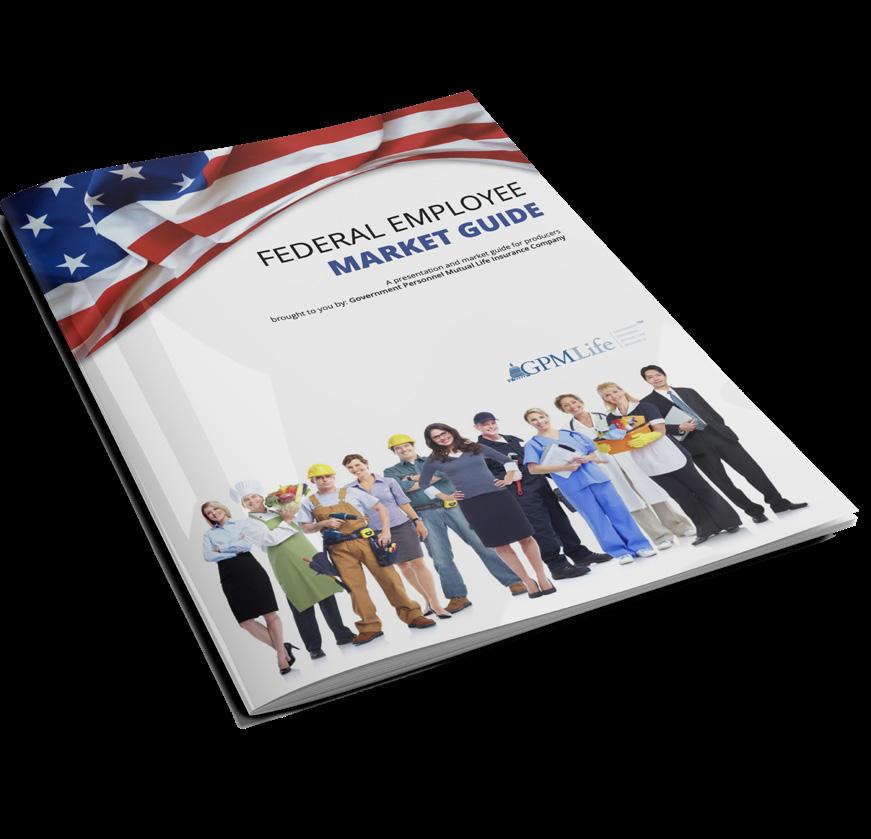
though the people at OpenAI have said they’re working on ChatGPT for business and GPT-4 for business, and that will include a mechanism for uploading your own data sets.
Feldman: What are some ways an insurance agent or financial advisor could best use this in their practice today?

Palmer: I think first off, productivity increases. The second thing is you can get good at automating some processes that used to take a lot of time. If you wanted to do a compare and contrast for clients, these are tools that do those kinds of analysis extremely well and lay out their thought processes.
To automate sales pitches, to automate any kind of go-to-market materials, or to take the go-to-market material that your big carriers are giving you and turn it into something that’s customized for clients based on the CRM — I think that’s really the magic here.
Feldman: Let’s say you have financial advisors and insurance agents who have consistently held seminars. If they’re doing two or three a week, and they do it for five or six years — or
Any process where you ever sat down to enumerate any workflow for internal or external use will be done faster, cheaper, more efficiently, more productively by these tools.
whatever that period is — could AI tell them what their conversion rates are, what their closing ratio was? Maybe tell them when the optimal time is to follow up, what’s the best email to send? With CRMs today, you collect a lot of data, but a lot of people aren’t utilizing that data, aren’t making it actionable.
Palmer: You’re 100% right. We collect data, but you need to make it actionable. Most people do not have the tools to make the data actionable. The way that most people would use Salesforce or a CRM system like HubSpot when they’re talking to someone is they would see their last notes: “How was your trip to Bali with your wife?” and “So last time we were talking about cyber insurance, where’d you guys land on that?” That’s how you would use it, and you might go back a little bit further or review some of the policies they already have. You might even farm it a little bit for some metadata to send a bulk email, but that’s not the same as pulling real insights from the data that you collect.

We train the AI, but the AI is training us. Once you start to get familiar with the kinds of insights that you can gather, you’re going to collect different data because it will help you do better.
Feldman: It’s amazing how in the last six months, the whole world has changed, and that’s just from a consumer perspective.
Palmer: We haven’t even started to talk about the way they’ll use this for advertising, and building custom ads, and social selling. So, if you tend to use the internet, if you tend to use social media, if you are someone who advertises on Twitter or LinkedIn or Facebook or Instagram or Snapchat, you can use it to build out these programs. It also does a really nice job of responding. You can give it a range of responses, and you can have it automate the responses if you want to keep active on Twitter or LinkedIn. There’s just no end to how you can use this.
People at Adobe just came out with Firefly. I would say within just a few months, Midjourney will have an application programming interface, and it will handle text better.

And Canva already has incorporated some AI into their social art tools. So right now, for someone who runs an agency, go look at Canva and see how you could automate your news items that you put into LinkedIn or Facebook stories or Instagram stories or in a carousel.
Firefly ultimately will be the Adobe answer to that, which will be the higher-end, more robust version, although Firefly is amazing. There’s a video company called Runway, which does browser-based video editing. It’s spectacular. If you were doing production artwork and promotional materials, there’s a world of these tools out there.
There’s a website called Futurepedia.io. I believe they have created the largest, most comprehensive database of emerging AI tools. They haven’t had a chance to vet them all, so you go there at your own risk. What I do like about Futurepedia, though, is that it is a comprehensive list. You can go there and see what’s new.
You need to use this every day in your business. You also must go to their terms of service and check the box that says they’re not allowed to look at your information for quality assurance purposes, so that it is protected. The best thing you can do is reach out to their sales department, get a commercial API for your business, and build your own chat client or your own interface sitting above GPT-4. And the reason for that is that then, by contractual agreement, they can’t look at your data, so your data becomes your own.
Privacy and security are important here, but for every purpose that most people would use ChatGPT Plus, you can just go check, “You can’t use my data for quality assurance.” And then your data is yours.
These models don’t learn from you. They don’t remember; they have no memory. You will keep a separate chat for each individual thing you’re doing. So, client A gets their own chat, client B gets their own chat. It’s costly because those chats get longer. The model, because it has no memory, must read it every time. So, the best practice is to have an individual chat for each task that you’re trying to accomplish or each client individually.
Feldman: One of the things that’s an issue right now is what are called AI hallucinations. Hallucinations are when AI will literally just make something up. Is that just something we must accept for now and make sure we verify everything? Will AI get beyond the hallucinations at some point?
Palmer: It’s a great question it’s an important question. There are several different solutions. The main solution is you must bring a lot of subject matter expertise to both the input and the output. The better you are at your job providing input, the better ChatGPT will be at helping you do your job.
Second, this concept of embedding and context injection — creating your own database that restricts what the model will use as input — will help curb hallucinations dramatically. Third, human beings have to understand that the conversational AI interface was specifically built to trick you into believing you’re talking to a human, and so people immediately fall into that trap.
The evolutionarily stable way for human beings to interact with one another is called the “default to trust.” The default to trust is that until you prove yourself not to be trustworthy, I’m going to trust you.
The only evolutionary stable strategy for human beings to interact with large language models and artificial intelligence is a default to distrust of the machine. You must immediately assume 100% of what you’re reading is nonsense, and if anything feels like nonsense, you ask about it.
Feldman: So how do we get better at that? Everything that you do should be reviewed if you’re going to use ChatGPT. Content creation is one thing that is very important for insurance agents and financial advisors. So how much of it do we trust? How much do we verify?

Palmer: If you bring more expertise to it, you will get more out of it. But even if you don’t bring anything to it, you’re still going to get something out of it. The hallucinations problem isn’t going away anytime soon. Nobody really understands why that is. There’ll be some guardrails put up there. This is early days.
If you go to shellypalmer.com and subscribe to our newsletter, we will try to stay on top of it. But more
importantly, you need to stay on top of it however you can. And there are lots of newsletters out there. There are plenty of videos on YouTube. There’s a lot of reading to be done. Nobody wants to have to learn something new every 15 minutes, but right now, you must learn something new every 15 minutes.
You must do this, because if you get this wrong, someone’s going to basically be able to take your business away from you.
Feldman: It’s either you surf it or you get crushed by the wave.
Palmer: Yes.
Feldman: Where are we going to be in one year from now with AI?
Palmer: No idea. What I do know is that there will be a catastrophic AI event sometime in the next 12 months. I don’t know what it’s going to be. Stock market crash, airliner forced down by misinformation,
something horrifying. It’ll get in front of Congress, and we’ll have a little come-to-Jesus moment, and that’s going to sober everybody up. That’s my prediction. Something terrible is going to happen because no one knows — we’re literally standing knee-deep in gasoline and we’re playing with matches, and I have no idea where this is going.
If you are not terrified by this, you don’t know enough about it. If you’re not excited beyond anything you’ve ever seen before, you don’t know enough about it. Those are just two emotions that generally don’t come together at the same time.
Maybe the only other time I’ve ever felt this way was only for a few seconds. I was honored and lucky enough to jump out of an airplane with the Golden Knights, which is the Army’s crack tandem skydiving team. And they took me up to 10,000 feet, and they strapped me to a young man I entrusted my life to. The two of us, strapped together, jumped out of the airplane.
I had never been more thrilled and more terrified at the same exact time in my life. That first 15 seconds — when you are just falling through the air from 10,000 feet, abject terror and you could taste the adrenaline in your mouth — that’s how I go to work every day now.

That’s my prediction. Something terrible is going to happen because no one knows — we’re literally standing knee-deep in gasoline and we’re playing with matches, and I have no idea where this is going.Yep, you guessed it. Midjourney, again.


•
•
•
•
Insurers are showing hiring optimism, as 67% of them have plans to increase their staff during the next 12 months, driven by the property/casualty segment at 69%. In addition, 79% of companies expect to grow revenue during the next 12 months. This is according to a study by The Jacobson Group and Ward, part of Aon plc.
In addition, 93% of life/health companies expect an increase in revenue, and 50% of the companies stated that change in market share will drive their expected revenue changes. Thirty-five percent also cited pricing factors.
The primary reason companies plan to increase staff during the next 12 months is an expected increase in business volume, the survey said. More than two-thirds of companies (37%) listed this as the primary reason to hire, followed by areas being understaffed.
In addition to these plans for growth, 10% of companies are planning to decrease their number of employees. When it comes to reductions in headcount, 8% of companies report that reorganization will be the primary reason for this activity during the next 12 months.
Nearly half (42%) of all advisors expect the impending recession to be short and shallow, beginning and easing gradually, while under a quarter (23%) expect a significant and prolonged market downturn marked by stagflation and instability.
Is this a financial crisis? Four in 10 investors said they think so in a recent Nationwide Advisor Authority study. Three in 10 (30%) believe the U.S. is approaching one, and only 36% are confident that they will survive the next financial crisis despite living through many prior episodes.
Survey respondents say financial crises feel more like an inevitability than a possibility. One-fifth (20%) of investors expect to face two more financial crises in their lifetime, and nearly half (43%) expect to face three or more. In addition, many are worried that their finances will not survive the next market downturn, with nearly 4 in 10 (39%) investors indicating that after living through a previous crisis, they are more nervous about their ability to protect their finances.
As investors across older generations rely on previous lessons learned, many are bracing in anticipation of an economic downturn. For example, 38% of Gen X and 29% of baby boomer investors expect a prolonged period of severe downturn marked by stagflation and instability. What’s more, they don’t expect this to be the last crisis they live through. Twothirds (65%) of Gen X and almost half of baby boomers (48%) expect to live through at least two more financial crises in their lifetimes.
‘UNREGULATED
Singer and megastar Taylor Swift decided to “shake it off” when offered the opportunity to endorse FTX. Swift is the lone celebrity pursued by disgraced cryptocurrency developer Sam Bankman-Fried who asked the right questions about FTX, an attorney suing SBF said.

“[She] actually asked that, ‘Can you tell me that these are not unregistered securities?’” Florida attorney Adam Moskowitz said. Moskowitz filed a November
class-action lawsuit against SBF and the roll call of celebrities who endorsed FTX, including Tom Brady, Gisele Bundchen, Shaquille O’Neal and Larry David. He said Swift was the only celebrity who bothered with due diligence when presented with their FTX sponsorship offer.
As for Swift, we can only guess that she is saying, “We are never ever getting back together” regarding lending her celebrity status to FTX, and she is probably glad she won’t have to cry “Look what you made me do” in the future.
Nearly two-thirds of Americans (65%) say no to raising the retirement age for those who are currently in their 20s, according to a poll by Data for Progress. Increasing the retirement age is one idea that has been floated as a way to keep Social Security solvent.
A closer breakdown of that figure showed opposition extended beyond party lines for respondents, as 72% of Democrat-identifying respondents and 59% of Republicanidentifying respondents also said it was “unfair” and “unrealistic” to expect younger Americans to work into their 70s. Sixty-five percent of respondents who identified as independents or third-party voters also said the same.
Less than 10% of Americans polled said they supported raising the full retirement age above 67, the current threshold for those born since 1960, with only 5% of Democrat-identifying respondents and 9% of Republican-identifying respondents backing the move.
If the 24% cut in Social Security benefits under current law goes into effect, it will double the rate of poverty among the elderly.
— Sen. Bill Cassidy, R-La.
The share of households reporting that it has become harder to obtain credit today than it was a year ago rose to its highest level since at least 2013.Sales/marketing. Product management. Operations. Actuarial. Source: The Jacobson Group and Ward Source: Nationwide Advisor Authority study
Grow your agency
• Customized targeted recruiting plan, agent recruiting leads, onsite and virtual open house recruiting events.
High-touch personal attention
• Producers enjoy direct access to underwriters and sales support teams.
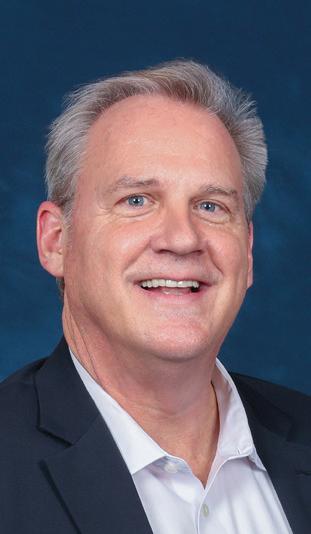
Elevate your agency with customized training

• Advanced and business markets, sales concepts, case design, and support staff assistance team.
Exceptional regional team to support your agency
• Annual business planning and monitoring, onsite training, team-building events
Full suite of products to help you stand out from the crowd
• Innovative term insurance to age 85.
• Outstanding return-of-premium products.
• Streamlined indexed universal life insurance design.
• Unique ability to add a commissionable policy enhancement that allows the policyowner to customize the way the death benefit is paid out
• Founded in 1895, a producer-focused Company with fourth generation family leadership that has great financials and no debt.
For information about a vested independent contract with Kansas City Life Insurance Company, call Tom Morgan, Vice President, Agencies, 855-277-2090, or visit join.kclife.com.

Annuity sales are smashing all historic records as consumers flock to protection products. But game-changing federal regulation looms.
By John HiltonAnnuity sellers are sitting atop a mountain of goodness.
Nearly all product lines are selling strong or boast a positive outlook, and successful technology adoption is proceeding with alacrity. States coast to coast are adopting the industry-favored best-interest sales rules.
It’s all contributing to sales so strong that calling them simply “record breaking” almost undersells the market heat — more like record shattering. Firstquarter annuity sales totaled $92.9 billion, a 47% increase from the prior year, according to LIMRA’s U.S. Individual Annuity Sales Survey.
That follows sales of $310.6 billion in 2022, a 22% increase from 2021 results and 17% higher than the record set in 2008.
rule forced the industry into a costly revamp of sales practices. It also swung many more potential annuity sales into the unsuitable category.
And the bottom line suffered. In 2017, annuity sales plunged to $204 billion, the sales nadir of the past decade.
Jim Szostek is vice president and deputy, retirement security for the American Council of Life Insurers.
“Fiduciary-only advisors generally require account holders to invest at least $100,000 up front,” Szostek said. “It is also worth noting that fiduciaries charge a fee for advice, generally on an ongoing basis based on assets under management. This works for those with significant assets.
“But it doesn’t work for most working-class families who are most likely to benefit from income guarantees in retirement through an annuity.”
deferred annuities and indexed annuities, which shield owners from the volatility of stocks and bonds.
Even a solid rebound for equities this year — the S&P was up nearly 7% as this issue went to press — is doing little to subdue the desire for protection annuities.
“Market conditions continue to drive investor demand for annuities,” said Todd Giesing, assistant vice president, LIMRA Annuity Research. “Every major fixed annuity product line experienced at least double-digit year-over-year growth.”
Demand for annuities is so strong, many carriers are having trouble keeping up. Industry social media chatter is buzzing with talk of annuity applications delayed for weeks.
“We obviously had a ton of volume coming through in protection-focused annuity product,” Giesing explained. “And that was simply a distraction. We’re
$
Source: Secure Retirement Institute, Preliminary U.S. Individual Annuity Sales Survey, First Quarter 2023
But faint as they might be, there are potential storm clouds lingering on the horizon.
The Department of Labor is expected to publish a new fiduciary rule by the end of 2023, a rule change that would likely upend annuity sales practices. It’s the second attempt by the DOL to extend a fiduciary duty to annuity sales and other retirement fund transactions.
Finalized in 2016, the first fiduciary
The S&P 500 stock tracking index firmly turned bearish last June. Since the start of 2022, the index is down 14%. Combined with other skittish economic indicators, such as rampant inflation and recession talk, retirement investors fled the market in fear.
Protection-focused annuities is where they ended up parking their money — products like fixed-rate
hearing from the industry that there have been backlogs and that insurance companies had to quickly expand their headcount in new business processing to be able to handle the volume.”
Many insurers are quickly pivoting to technology to help process applications faster. During Prudential’s first-quarter earnings call last month, Chairman and CEO Charlie Lowrey noted “a significant increase” in sales of fixed annuities.
He credited technology, in part, for the boost.
For example, a majority of annuities applications are now submitted with electronic signature, Lowrey added, “which has reduced processing time by several days and improved our environmental impact.”
Historically, the stock market gains over time and the bulls will eventually run again. The Dow Jones Industrial Average gained a modest 1% through the first four months of 2023. LIMRA is predicting slow and steady growth in equities through 2028.
to downside risk and provide the opportunity for growth, usually through a market index.
RILA products offer more growth potential than fixed annuities, but less potential return and less risk than variable annuities.
Introduced in 2010 by AXA Equitable Life Insurance Co., now known as Equitable, it took some time for RILAs to catch on. Sales topped $11 billion in 2018, and carriers rushed products to market to catch the RILA trend.
or to start to see some share get diluted from top carriers. We’ve seen a little bit of that, but for the number of carriers that have come into the market and you’re still seeing exponential growth? It’s almost unprecedented.”
RILA contract premium increased 11.4% in 2021, and White noted that 61% of RILA premium is money new to the industry — in other words, not funds swapped from an existing annuity.
In response, annuity buyers will surely turn away from protection-centered products such as fixed-rate deferred. LIMRA forecasts about a 30% decline in this category, but Giesing noted that even with the projected decline, those are still historically strong sales.
But that decline does not mean the selling party has to end. If the industry has proven anything, it’s that annuity manufacturers have a product for all seasons.
In good market times, that product is registered indexed-linked annuities. Also known as structured or buffered annuities, RILAs are a tax-deferred longterm savings option that limit exposure
Today, there are 17 carriers offering RILAs and more than $41 billion in annual sales. Transamerica, Global Atlantic and Sammons all brought new RILA versions to the market in 2022.
With interest rates climbing higher seemingly each time the Federal Reserve meets — the Fed hiked its benchmark borrowing rate again in May to a target range of 5% to 5.25%, a rate not seen since 2007 — RILA sales growth was expected to halt.
That has not happened.
In fact, RILA sales expanded by 6% from 2021 to 2022, said Sutton White, head of annuity product for Life Innovators.
“We’re still seeing growth, even as we’re seeing new carriers [introduce RILAs],” White pointed out. “You would expect to see growth potential flatline
The RILA Act awaits President Joe Biden’s signature and could further boost sales. The bill would lower barriers to retirement income products by requiring the Securities and Exchange Commission to revise rules regarding developing and offering certain annuity products, including RILAs.
If signed into law, the bill will direct the SEC to create a new form to replace the forms annuity issuers currently are required to use when filing RILAs with the commission. These forms require the disclosure of financial information in line with GAAP, as well as other extensive information that is irrelevant for prospective annuity purchasers, industry lobbyists say.
Most notable is the S-1 form, filed with the SEC. The number of carriers offering
RILAs could double if the RILA Act becomes law and they are not required to file the more cumbersome S-1 form, White predicted.
Furthermore, talks with the Interstate Insurance Product Regulation Commission to add RILAs are nearing a successful conclusion, White said.
Created by the National Association of Insurance Commissioners in 2002, the interstate insurance compact reviews and approves (or disapproves) individual and group annuity, life insurance, disability income, and long-term care insurance products.
account into a stream of periodic payments. VAs grew wildly popular while the stock market regained strength in the years after the 2008-09 economic crisis.
Sales were too good.
Eventually, carriers became nervous about the amount of VA guarantees on their books, Giesing noted, and adopted different strategies to counter that risk.
The lone Debbie Downer in this whole rosy scenario is the looming fiduciary rule. DOL officials are notoriously tight-lipped about rules in progress and could not be reached for comment.
However, industry lobbyists feel good about having a precedent set by the 5th U.S. Circuit Court of Appeals in 2018, when a 2-1 ruling tossed out the fiduciary rule published by the Obama-era DOL.
“Carriers started to say, ‘Okay, we want to balance out our annuity portfolios and our annuity sales,’” he said. “So they started diversifying, offering products without guaranteed living benefits or looking at other product lines and putting an emphasis” on other annuity categories.
11.4%
“RILA is not in the compact currently,” White explained. “So not only do you have to go through the arduous process of filing Form S-1, but you also then have to do a state-by-state filing of the final product, which ‘tedious’ doesn’t even begin to describe because there’s not really a lot of consistency [from state to state].”
Variable annuities were once the prettiest products on the shelf. At their 2011 peak, VA sales topped $156 billion, the majority of them with guaranteed living benefits.
Traditional VAs include an investment account that may grow on a tax-deferred basis and include certain insurance features, such as the ability to turn an
Source: LIMRA SRI, 2022: A Deeper Dive into Registered Index Annuities
VA sales plummeted steadily, registering just $61.8 billion in 2022, the lowest full-year sales since 1995. Traditional VA sales were $12.9 billion in the first quarter of 2023, down 30% from first-quarter 2022 results.
But Giesing and LIMRA say VAs still have a place in the market. LIMRA forecasts call for a gradual uptick in VA sales to the $80 billion range by 2027. At $198,000, the average new contract premium for VAs with guaranteed living benefits is very high.
“Very lucrative and one of the highest average commission premiums for contracts,” Giesing noted.
Since then, the Trump administration published the investment advice rule, a surprisingly strong effort. The department was immediately sued twice over a portion of guidance issued in 2021 that expanded the definition of a retirement plan fiduciary.
The DOL wants most of all to extend fiduciary duty to advisors who handle “rollover” planning. According to the Investment Company Institute, 401(k) plans hold $6.3 trillion in assets as of Sept. 30, 2022, on behalf of about 60 million active participants and millions of former employees and retirees. When recipients retire and the money is “rolled” out of those plans, many advisors earn a commission.
Regulators consider that a conflict of interest and want it to be considered fiduciary advice. The fiduciary standard is based on the “five-part test” established
in 1975, in which one of the prongs is whether the advisor and client are in an “ongoing relationship.” In order to satisfy that prong, the DOL claims a one-time rollover contains the expectation of future advice rendered.
A federal district court judge in Florida struck down the guidance in a February ruling that has been appealed by the DOL.
Judge Virginia M. Hernandez Covington ruled that a portion of the department’s frequently asked questions guidance illegally widened its regulatory lane and failed to comply with the agency’s own regulations.
“While an offer to provide future
advice may, as the Department suggests, be the beginning of a relationship, that relationship is inherently divorced from the ERISA-governed plan,” she wrote. “Because any provision of future advice occurs at a time when the assets are no longer plan assets, it is not captured by the ‘regular basis’ analysis.”
So, we wait.
In April, Washington and Wyoming became the 35th and 36th states to adopt the NAIC best-interest standard for annuity sales and recommendations. States have swiftly responded to lobbying efforts that ramped up following the 2020 model adoption by insurance commissioners.
It mirrors the best-interest regulation adopted by the SEC in 2019 for broker-dealers and registered representatives.
“A best-interest standard is better,” Szostek said. “It protects consumers without making making access impossible for working-class Americans.”
InsuranceNewsNet
Senior Editor John Hilton covered business and other beats in more than 20 years of daily journalism. John may be reached at john.hilton@innfeedback. com. Follow him on Twitter @INNJohnH.

In this year’s Annuity Awareness Month Thought Leadership Series, great minds from two elite companies offer their perspective on product, process, and the future of an everchanging annuity marketplace.

Harnessing AI for fixed indexed annuities: A new era of opportunities
by IbexisPAGE 20
The evolution and advantages of custom indices with Adam Politzer, Senior VP
and Chief Product Officer,Athene PAGE 22

Artificial intelligence-enabled indexes have the potential to revolutionize the way we think about investing in indexed annuities.
Leveraging AI and machine learning indexes offers dynamic, adaptive and data-driven investment strategies that differ from traditional indexes in key ways, such as asset selection, weighting, rebalancing, adaptability and data analysis.
While traditional indexes still have a place in fixed indexed annuities, AI-enabled indexes make an excellent complement. In this article, we’ll explore the benefits and demystify the use of AI in an index.
The power of AI lies in its ability to process vast amounts of information to make data-driven decisions. Because it can analyze data at lightning speed, AI offers significant advantages over traditional human analysis. It can sift through years of a company’s financials, for example, much faster than an analyst could, allowing quicker and more accurate decision-making.
AI can interpret news and market dynamics and analyze other factors to make real-time investment decisions with the latest information, solidifying it as an invaluable tool for managing investments.
Additionally, AI eliminates factors like emotion that can greatly affect investment decisions, often leading to suboptimal results. This helps ensure a greater likelihood of investment choices that are based on data and objective analysis.
While the power of AI is unquestionable when it comes to analyzing vast amounts of data to make data-driven decisions on a monthly, weekly or daily basis — like whether to shift in and out of global equities, gold, bonds or exchange-traded funds — AI does have limitations. It may not always be able to interpret nuances of human behavior or unprecedented events and their impact on the markets. In light of that, it’s important to view AI as a tool that can assist in investment decision-making rather than as a replacement for humans. By combining human expertise and AI-powered analysis, we can achieve better investment outcomes that reflect the best of both worlds. And as more carriers begin using AI-enabled indexes, we drive innovation and make our industry more efficient.
Back in the heyday of variable annuities, everyone talked about “rider wars” and which company was going to have
the best living benefit or income benefit. Today, it’s a battle of the indexes. As a way to adapt to changes in the economy, changes in interest rates and the volatility of the markets, indexed annuities have evolved since the early days of using only standard S&P indexes. Now investors have access to an array of indexes with different methodologies, criteria and volatility controls, opening a wide range of investment strategies that previously were inaccessible.
“As we continue to face financial uncertainties, AI will undoubtedly play an increasingly important role in helping investors succeed in complex markets.”
AI-powered indexes represent the next step in this evolution.
AI indexes have the ability to quickly adapt to ongoing market changes and optimize returns, potentially outperforming traditional, rules-based indexes set by human analysts. During the pandemic, AI-enabled indexes proved their worth by quickly adapting investment strategies, minimizing losses and capitalizing on opportunities that human analysts might have missed. For instance, one AI index invested in Moderna after interpreting a press release about its COVID-19 vaccine development and invested in Campbell Soup Company based on buying behavior during historical events such as the pandemic.
With a rules-based index, the index is constructed and maintained in accordance with a set of rules, whereas an AI index is designed to learn from and adapt to market changes. It’s not limited by fixed rules or predetermined parameters, which allows it to pivot and optimize returns more efficiently.
As we continue to face financial uncertainties, AI will undoubtedly play an increasingly important role in helping investors succeed in complex markets.
— Ryan Lex, Ibexis chief distribution officer
While we can tout the benefits of using artificial intelligence, a major misconception about AI is that it’s a “black box.” The good news is that carriers like Ibexis are making an AI index more of a “glass box,” providing transparency by enabling producers to understand why AI is making certain decisions to reallocate.
This eliminates the fear of the unknown and empowers producers and their clients to capitalize on the opportunities AI affords.
To be on the cutting edge of the AI revolution in insurance and financial services, partnering with established carriers and index partners that have demonstrated a strong commitment to innovation and technology is essential. These partners make ideal collaborators for exploring the potential of AI in fixed indexed annuities, as they have the expertise to handle the complexities of the technology and develop new investment strategies that fully leverage its capabilities.
Additionally, as AI continues to improve itself through machine learning, it will play an increasingly important role in shaping the future of the index market. By being transparent, carriers like Ibexis hope to stimulate awareness of and interest in indexes that can provide investors with even greater opportunities for diversification, optimized returns and risk management, now and into the future.


Leveraging AI’s analytical capabilities to make better portfolio allocation decisions in an index and help investors make more predictable decisions over time potentially leads to smoother returns and improved risk management.
AI can play a crucial role in providing smoother returns in indexed annuities by determining and predicting appropriate volatility targets for indexes. With the industry trending toward increased volatility targets — ranging from 7% to 12% on some products — AI’s ability to process and analyze historical data can help set more accurate targets that better reflect market conditions and investor expectations.

AI also can be employed to develop and manage a dynamic allocation strategy within the indexed annuity. By continually analyzing multiple asset classes, such as stocks, bonds and commodities, it can determine the optimal allocation mix that maximizes returns while managing risk.
Jim Simons — a pioneer in using AI and machine learning to make more informed trading decisions in real time, generating market-beating returns and growing a multibillion-dollar company as a result — serves as a powerful example of the vast impact AI can have on the financial industry. While not everyone can expect the same level of success, Simons’ achievements demonstrate the incredible potential of AI.
Carriers like Ibexis and others, and their index partners, have extensive resources and proven track records of success, which makes them well positioned to drive the future of AI-powered indexes and shape the investment landscape for years to come.
As the financial industry continues to evolve, we’ll likely continue to see a variety of indexes enter the market and a growing interest in AI-enabled indexes. This competition is healthy, driving innovation and encouraging the development of more advanced investment strategies. That said, even with an increasing reliance on AI, humans will continue to play a crucial role in setting up the structure of AI indexes, ensuring the technology is guided by expert knowledge and experience.
The age of AI is here, and we must embrace it. The future of our industry is dependent on those willing to seize this new opportunity. It’s why we have to stay informed about industry trends and recognize the importance of collaboration between human expertise and AI capabilities. This combination acts as an advanced and sophisticated tool in our toolbelt. It’s one we can use to better navigate the complexities of the financial world and make more-informed decisions that help clients achieve their financial goals.
“To be on the cutting edge of the AI revolution in insurance and financial services, partnering with established carriers and index partners that have demonstrated a strong commitment to innovation and technology is essential.” — Ryan Lex, Ibexis chief distribution officer
Custom indices are gaining in popularity as a means of helping clients meet their financial goals. Athene, a leading provider of fixed indexed annuities, is at the forefront of this trend with its innovative custom index solutions.
In this interview, Adam Politzer, senior vice president and chief product officer, speaks to INN about what makes custom indices so effective at providing clients with value and protection from market downside.
INN: Can you set the stage by explaining what custom indices are and how they differ from benchmark indices like the S&P 500®?
Politzer: When we talk about custom indices, we’re referring to a specialized type of index designed to work within a fixed indexed annuity (FIA). While most people are familiar with benchmark indices like the S&P 500®, a custom index is tailored to track a specific investment style and typically includes exposure to a range of asset categories such as equities, bonds and commodities. One important distinction of custom indices is they’re entirely rules-based, which means performance is mathematically driven as opposed to people-driven, so generally more accurate in terms of what’s happening in the market.
INN: What inspired Athene’s use of custom indices, and what’s changed in recent years that you see as a benefit to clients?
Politzer: The inspiration for using custom indices in FIAs came from the limitations of traditional point-to-point caps on the S&P 500®, which offered decreasing growth potential as rates fell. Custom indices were introduced to meet the need for higher growth potential. Since then, there's been an extraordinary amount of innovation.
Unlike the S&P 500®, custom indices were designed to provide more consistency and predictability, making it possible to offer better rates and an improved experience. Moreover, custom indices allow for greater diversification, exposing clients to a broader range of asset classes. Additionally, our custom indices are built on fundamental principles that aim to maximize growth potential for the amount of risk taken, which differs from the S&P 500®’s purpose of tracking the 500 largest companies.
These factors combined have led to the creation of better financial products, including the current generation of FIAs.
INN: Some financial professionals may be skeptical of the accumulation potential shown for custom indices. How do you respond to this concern, and what strategies are used to optimize growth while minimizing risk?
Politzer: It can certainly be difficult to keep track of the various components of the many custom indices in the marketplace today as well as understand how those components are valuable to clients, which is why education is so important. Custom indices are primarily designed to provide protection from market downside.
All of the underlying components are familiar benchmarks or investable products with plenty of liquidity. These underlying components have been around for years, and because the indices are fully rules-based, we’re able to show how these indices would have performed prior to them being in existence.
While our custom indices show strong performance when tested retroactively, we believe they are designed to work prospectively as well because they are built on strong academic principles, like diversification, which hundreds of years of data has proven effective.
INN: To anyone who believes custom indices are inherently complex and not as transparent as benchmark indices, what would you say, and what steps have been taken to improve transparency and understanding of these indices?

Politzer: We understand custom indices can be complex, but we firmly believe they create value for clients. To improve transparency and understanding, we’ve worked with The Index Standard® to focus on 122 years of custom indices research (Athene.com/INN-IndexResearch) to both explain how they work and would have performed in various market conditions.
As more complex indices enter the market, it’s important to ensure they’re built on sound financial principles and not just designed to perform well in a historical backtest. At Athene, we make sure everything we introduce into an index makes academic sense and is built on solid principles. The volatility control features on our indices allow for greater stability and predictability of the index’s performance. For example, one of our index’s volatility control is balanced every hour. This results in better pricing and interest credits for clients.
INN: Since protection from market risk is intrinsic to a FIA, what role does volatility control play in a custom index?
Politzer: Firstly, it allows us to offer greater participation rates, often in excess of 100%, without a cap.
This is because volatility controlled indices are easier to hedge because they result in a smoother performing index. Secondly, volatility control helps to ensure more consistency in renewal rates, as we can be more confident in the cost of these options and offer clients consistent participation rates at renewal.
While some financial professionals may initially question the need for volatility control in a principal-protected product, we believe it plays a critical role in optimizing growth potential and reducing risk.
INN: Can you talk to us about the volatility target on a custom index compared to the volatility of the S&P 500®?
Politzer: When it comes to the total value we provide our clients, we allocate the same option budget regardless of the index strategy. The native volatility of the S&P 500®, which people may be familiar with, is usually around 20%. If we have a 3% option budget, we may be able to offer 50% exposure to that index on a given day.
However, if we add a volatility control with a target of 5%, which is a quarter of the volatility of the S&P 500®, we could potentially offer participation rates that are four times as high. This means the total value of the product
almost every economic environment. Our expertise in curating the best set of index solutions and having a wide selection of indices allows clients to take advantage of the diversification we offer. By spreading money across these index strategies, clients are more likely to have a consistent experience and accumulation within the products.
INN: How do you see custom indices evolving in the years ahead?

Politzer: Athene is a company that strives to stay ahead of the latest innovations, and I can tell you that custom indices are only going to get better in the years ahead. We’ve already seen exciting developments, like more sophisticated versions of volatility control and the use of AI to pick better stock portfolios and macro investment strategies for indices. And I’m confident these trends will continue, leading to even more effective and efficient index solutions for our clients.
But it’s not just about the latest technology; diversification will also remain crucial. By offering a wide range of custom indices that can help provide that diversification, we can help our clients navigate whatever comes their way.
INN: What advice would you offer financial professionals who are considering using custom indices, and what resources would you recommend to help them explain the value to their clients?
remains the same, but with the addition of volatility control, we can offer clients greater growth potential with a smoother-performing index.
INN: What would you suggest a financial professional and their client consider when comparing one custom index to another?
Politzer: When comparing custom indices, it’s crucial for financial professionals and their clients to weigh the client’s goals and need for diversification.
Additionally, it’s important to consider that participation rate multiplied by index performance is what determines the index return. So, to make an apples-to-apples comparison, you need to understand the participation rate relative to the index return.
For example, a 10% return with a 50% participation rate would result in a 5% interest credit, while a 5% return with a 200% participation rate would result in a 10% interest credit. Ultimately, it’s not just about the pure index return, but also the strategy performance over time.
INN: What do clients expect from an index and how are Athene’s custom indices designed to meet and exceed these expectations?
Politzer: Athene’s custom indices are designed with diversification in mind to help ensure they perform well in
Politzer: We recognize the importance of simplifying custom indices and making them easily accessible for financial professionals and their clients. That’s why we’ve invested significant time and resources into quarterly webinars with our partners and creating dedicated webpages, providing a comprehensive library of materials.
These resources range from beginner-level content to more sophisticated information on how custom indices work and improve financial outcomes to point-of-sale collateral. Our content is designed to be easily digestible, providing small, bite-sized chunks of information that can be shared with clients. In addition, we offer simple recommendations on how to build a properly diversified portfolio with our indices.
Athene.com/INN-IndexInsight.

To learn more about the value of custom indices, visit
As more complex indices enter the market, it’s important to ensure they’re built on sound financial principles and not just designed to perform well in a historical backtest.
Bryan Kuderna was in college and trying to make up his mind about his future. Should he continue as a marketing major? Pursue a career with the federal Drug Enforcement Administration? Switch majors to something more “practical,” such as accounting or finance? Then there was his love of writing — maybe declare a minor in journalism?
Kuderna opted to change his major to finance and accepted an internship in a small financial services firm affiliated with Guardian. And he never looked back.
Today, Kuderna is founder of Kuderna Financial Team in Shrewsbury, N.J., and he is still a part of the financial services firm in which he started his career as a junior at the College of New Jersey. His love of writing inspired him to pen two books about wealth management as well as a fantasy novel and a long-running blog, Weekly Wealth Wisdom.
Growing up, Kuderna said, he was interested in law enforcement. But he also was interested in becoming a business owner. “I loved the idea of controlling your own destiny and being an entrepreneur,” he said. He also managed his college newspaper and found his passion for writing.
But it was an interview with the DEA that solidified his path to a financial services career.


“They asked me if I had a pilot’s license, and I did not,” he said. “Then they asked me if I spoke a second language other than Spanish, and I did not. They asked me what my major was, and I said it was marketing. They said, ‘Everything that we do is about following money. So if you want to even try and have a shot at the job with us, you need to change majors to either finance or accounting.’”
Instead of further pursuing a DEA career, he changed his major to finance

and began the internship that launched his career.
But starting out in the industry wasn’t easy for someone who hadn’t even graduated from college yet.
“It was very much go try and find your natural market or draw up your list of your target 200, things like that. And I was like, ‘Well, I’m 20 years old. There’s not really a natural market here.’”
Without a natural market to help him get started, Kuderna began cold-calling business owners to discuss employee health benefits to help get a foot in the door with that population. He also coldcalled CPAs “just to get in the know with some folks in the community.” But he didn’t have much luck in cold-calling with either group.
But he did begin to find success from attending networking events in his area — and he attended a lot of them.
“I did a ton of networking events, probably a couple of them a day — usually one for lunch, and then I’d go to a happy hour or something in the evening,” he said. “And I started to meet a lot of people in the area. It was a slow start those first couple of years. I was hardly staying afloat. I was living at home after I graduated from college.”
Those rough early years eventually passed when Kuderna discovered he had a talent and a passion for discussing financial literacy with the public.
“Where I really kind of hit the ground running was in putting together financial literacy talks — in particular, doing them at hospitals,” he said. “I created these financial education curricula to present to all the residents and fellows at teaching hospitals in the area, and that’s where my career really started to jump.”
Kuderna realized that newly minted medical professionals have a particular set of financial and insurance needs, and because he was about the same age as they were, he could position himself as a trusted source of advice.
“I was able to get in with them and kind of coach them,” he said. “I was right around their age, in my mid-20s, late 20s. I talked with them about their student loan concerns, kind of put them at ease there; talked a lot about disability insurance, which became a huge part of my practice.
I began to grow with them as they moved out of their residencies and began practicing and making money. Then I got licensed nationwide, and I expanded with them as they scattered all around the country.”
Kuderna continued to discuss financial issues in more hospitals. He earned his Certified Financial Planner designation in 2013, and he described that achievement as “giving me some credibility.”
Today, about 80% of Kuderna’s clients are dentists or physicians. He finds that one of their biggest issues is managing the massive student loan debt they carry after graduation.
“They come into the early years of their career feeling a sense of guilt that they’re
He described the book as “kind of a crash course on finance for the young professional.”

“It was part memoir, and a lot of it was based on the conversations I have with young professionals,” he said. “I was able to blend my old passion of writing with my new passion of financial education and what I do as my day job. The good part about writing the book is that it was supposed to help my clients and it also got my name out there.”
Kuderna switched gears during the COVID-19 lockdown to write a fantasy novel, Anoroc, which is “corona” spelled backward. The book is a coming-of-age novel that tells the story of a young boy living in a world where people compete for scarce resources.
“During quarantine, I was able to free up so much of my schedule because I was doing all Zoom calls instead of traveling,” he said. “I thought, now I actually can write something that’s a total escape from constantly talking about COVID-19 and finance and all the stuff that was going on.”
Kuderna said that after his second book was published, people asked him whether he planned to write a sequel to Millennial Millionaire. “Certainly there were a lot of things that happened in the economy since I wrote my first book in 2016,” he said. The result was his newest book, What Should I Do With My Money? Economic Insights to Build Wealth Amid Chaos, which was published in February.
not planning for retirement,” he said. “What I try to do is draw up a game plan with their student loans and get them to calm down. We come up with a strategy on how to deal with them. It’s not different from if you got a $600,000 mortgage. It’s not like your whole life stops; it’s just that you continue living now with that monthly payment. When they become attending physicians and their incomes start to rise, that’s when we’re able to help them start investing in their retirement plans.”
By 2016, Kuderna decided to indulge his passion for writing and merge it with his interest in educating people about money. He wrote his first book,
He said that the book begins with the original meaning of the word “wealth,” which comes from an Old English word, “weal,” which means “well-being.”
“I write about wealth in the context of well-being, not just in a monetary sense. I think that guides all economic decisions and all financial decisions. Every person is trying to make decisions for their own well-being.”
Going back to the days when he considered working for the DEA, Kuderna said he read a book on the Central Intelligence Agency that said that when they train their spies, they tell them to “look for the MICE.”
“MICE stands for money, ideology, compromise and ego,” he said. “Those four motivators make human
decision-making what it is. In my book, I took some of the most pressing issues today — from entitlements to education, environment, big tech, economic philosophies — and looked at them through the context of MICE. It’s not just money —
podcast,” he said. “Sometimes we address the podcast interviews or topics and elaborate on them.”
Kuderna ran his first marathon race in 2015, then followed it up by entering an Ironman competition in Quebec as a fundraiser for his local YMCA. Six years ago, he began practicing Brazilian jiujitsu. “It’s a good outlet not just for exercise but for learning a new skill that’s very complicated,” he said. “I made a lot of friends through it, and it became a kind of balance to my everyday workplace and family life.”

He plans to continue educating people about financial literacy.
An annuity is intended to be a longterm, tax-deferred retirement vehicle. Earnings are taxable as ordinary income when distributed, and if withdrawn before age 59½, may be subject to a 10% federal tax penalty. If the annuity will fund an IRA or other tax qualified plan, the tax deferral feature offers no additional value. Q ualified distributions from a Roth IRA are generally excluded from gross income, but taxes and penalties may apply to nonqualified distributions. Please consult a tax advisor for specific information. There are charges and expenses associated with annuities, such as surrender charges (deferred sales charges) for early withdrawals.
money is involved in everything — but it’s also about the other elements that guide our decisions.
“I look at all these from a micro standpoint of you and your financial plan and then a macro standpoint of here’s the construct that we all live in and you how to achieve economic literacy, so you understand why things are the way they are and
“There’s financial literacy, which is about how do I manage my bank account or what retirement plan is right for me? But then there’s economic literacy, which I think has not attracted the attention it deserves.
“When you’re dealing with clients, educating them is one thing, but then motivating them to take action is a completely different thing. I think our job as advisors is to say, ‘This is the right thing to do. Now how do I motivate you so that you say you want to do this and stick to the plan and have that discipline?’”
Kuderna said most financial and economic issues “come back to the question of why should I do this?”
Kuderna has expanded his reach into podcasting and blogging. He also has appeared as a financial commentator for several national media outlets.

“The podcast came first, in 2020. And the idea here is just giving little tidbits of financial literacy, 20-30 minutes on the basics. What is a Roth IRA? What are student loan repayment options? What is disability insurance? And that morphed into interviewing some big-name economists, professional athletes, business owners.”
The blog “became a supplement to the
“What I try to explain in my books is, this is the world we live in, this is how we got here, this is what the future looks like. Once you understand that, then you understand the answers of why you need to save and why you need to be worried about taxes and why you need insurance.”
Susan Rupe is managing editor for InsuranceNewsNet. She formerly served as communications director for an insurance agents’ association and was an award-winning newspaper reporter and editor. Contact her at Susan.Rupe@ innfeedback.com. Follow her on Twitter @INNsusan.

These materials are for informational and educational pu rposes on ly and are not designed, or intended, to be applicable to any person’s individual circumstances. It should not be considered investment advice, nor does it constitute a recommendation that anyone engage in (or refrain from) a particular course of action. Securian Financial Group, and its subsidiaries, have a financial interest in the sale of their products.
Insurance products are issued by Minnesota Life Insurance Company in all states except New York. In New York, products are issued by Securian Life Insurance Company, a New York authorized insurer. Minnesota Life is not an authorized New York insurer and does not do insurance business in New York. Both companies are headquartered in St. Paul, MN. Product availability and features may vary by state. Each insurer is solely responsible for the financial obligations u nder the policies or contracts it issues.
Securian Financial is the marketing name for Securian Financial G roup, Inc., and its subsidiaries. Minnesota Life Insurance Company and Securian Life Insurance Company are su bsidiaries of Securian Financial Group, Inc.
F For financial professional use only Not for use with the public This material may not be reproduced in any form where it would be accessible to the general public.





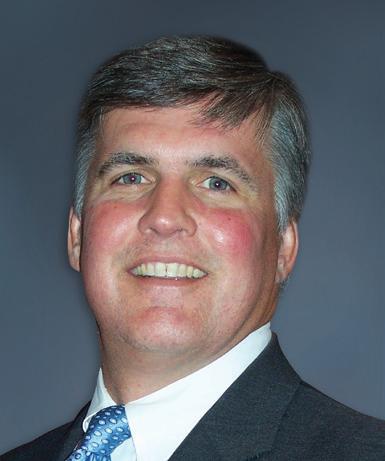



















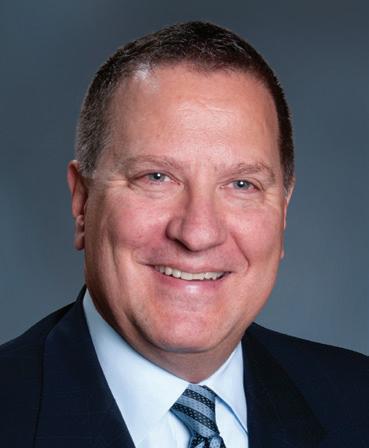










Membership does not imply a certain level of skill or training. Clients should conduct their own evaluation. See Membership Requirements at https://www.mdrt.org/join/member-requirements.



This information is provided by Ameritas®, which is a marketing name for subsidiaries of Ameritas Mutual Holding Company, including, but not limited to, Ameritas Life Insurance Corp. in Lincoln, Nebraska and Ameritas Life Insurance Corp. of New York (licensed in New York) in New York, New York. Each company is solely responsible for its own financial condition and contractual obligations. For more information about Ameritas®, visit ameritas.com.







Any agency referenced is not an affiliate of Ameritas or of any of its affiliates. DST 1423 4-23

 David A. McBride Sovereign Financial Group Midvale, UT
Franklin R. Mooney, LUTCF , MRFC, LACP Insurance Services Incorporation Peoria, IL
Timothy J. Moran, LUTCF UCL Financial/United Wealth Advisors Group Memphis, TN
David J. Fazzini, LUTCF Premier Planning Group Phoenixville, PA
Daniel J. Scholz, CLU, ChFC Amertias Wealth Advisors Omaha, NE
Jason M. Pratt Life Solutions Group Danvers, MA
Jonathan J. Pratt Life Solutions Group Danvers, MA
Scott C. Hanna Westpoint Wealth Management Willoughby, OH
Bret J. Klabunde inSOURCE Financial Advisors Omaha, NE
Curtis May Practical Wealth Advisor Lansdowne, PA
Michael C. Polin Premier Planning Group Phoenixville, PA
Kyle J. Christensen, CFP Unique Advantage San Antonio, TX
David A. McBride Sovereign Financial Group Midvale, UT
Franklin R. Mooney, LUTCF , MRFC, LACP Insurance Services Incorporation Peoria, IL
Timothy J. Moran, LUTCF UCL Financial/United Wealth Advisors Group Memphis, TN
David J. Fazzini, LUTCF Premier Planning Group Phoenixville, PA
Daniel J. Scholz, CLU, ChFC Amertias Wealth Advisors Omaha, NE
Jason M. Pratt Life Solutions Group Danvers, MA
Jonathan J. Pratt Life Solutions Group Danvers, MA
Scott C. Hanna Westpoint Wealth Management Willoughby, OH
Bret J. Klabunde inSOURCE Financial Advisors Omaha, NE
Curtis May Practical Wealth Advisor Lansdowne, PA
Michael C. Polin Premier Planning Group Phoenixville, PA
Kyle J. Christensen, CFP Unique Advantage San Antonio, TX
C. Robert Brown, CLU, LUTCF, UCL Financial/United Wealth Advisors Group
Richard T. Brunsman, CLU, ChFC, RT Brunsman Insurance & Investements
Anthony G. Butz, LUTCF, Premier Planning Group – Cincinnati
John Elias Calles, J.D., CLU, ChFC, National Wealth Group
Calvin Currinder, CLU, Carillon Group
Jack D. Gulati III, Premier Planning Group
Edward H. Harrell, CLU, Harrell-Virginia Beach
Carroll U. Hoffmann, Hoffmann Financial
Tobin C. Hoffmann, LUTCF, Hoffmann Financial
Bryan L. Holen, inSOURCE Financial Advisors
Dominick F. Impastato, Jr. LUTCF, United Wealth Advisors Group - Metairie
Wesley J. Keeton, The Keeton Group
Steve LaBella, Alpha Omega Wealth
Jennifer L. Larabee, Ameritas Financial Center - CFS
Valerie Laroque, Alpha Omega Wealth
Scott A. Leavitt, Gem State Financial Group
Young C. Lee, EMP Financial Network
Ryan S. Lim, EMP Financial Network
Dominick Luongo, Luongo & Associates
David E. McClure, Koehler Financial Group
Charles E. Nowlin, CLU, ChFC, Nowlin and Associates
Tyler J. Petersen, Sovereign Financial Group
Stanley B. Plocharczyk, CLU, ChFC, Plocharczyk & Associates
Ann Baker Ronn, LUTCF, United Wealth Advisors Group - Houston
Douglas A. Thompson, CLU, Executive Benefits
John B. Tickle, Houston Agency
Randall H. Trost, LUTCF, inSOURCE Financial Advisors
R. David Wentz, J.D., CLU, ChFC, Tax Favored Benefits
David W. White, CLU, ChFC, National Wealth Group
John E. Worrel, LUTCF, United Wealth Advisors Group - Metairie
Ameritas® and the bison design are registered service marks of Ameritas Life Insurance Corp. Fulfilling life® is a registered service mark of affiliate Ameritas Holding Company.
© 2023 Ameritas Mutual Holding Company
Eight out of 10 (82% of) Americans without life insurance think that people who have policies don’t fully understand them. When asked if they knew how their life insurance policy worked, only 57% of Americans said yes.
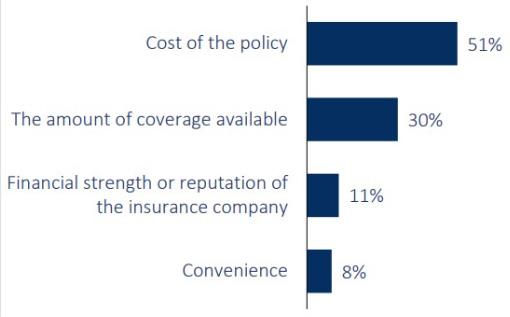
Source: Assurance
When it comes to buying life insurance, 92% of those who have purchased a policy believe it is worth the expense, while nearly half of those who don’t have life insurance have hesitated because of the monthly premium cost. This is according to a survey by Assurance on what Americans think about life insurance. The survey indicates:
• Nearly 1 in 4 Americans (23%) with life insurance wish they had purchased life insurance sooner.



• 92% of Americans with life insurance believe that their life insurance policy is worth the cost.
• 55% of Americans without life insurance said they plan to get it in the future.
• The biggest reason Americans without life insurance are hesitant to purchase it is the cost of the monthly premiums (45%).


Another reason Americans without a life insurance policy hesitate to buy it is their lack of knowledge about policy options (16%), the survey said. Only 15% of policyholders surveyed said they completely understand their policy. Nearly half (46%) of policyholders said they didn’t understand the difference between term life and permanent life insurance. Despite these potential barriers, 55% of Americans without life insurance plan to purchase it in the future.
In what could be a happy accident for the life insurance industry, young people think they are closer to death than they actually are. Nearly a quarter (23%) said they might die in the next 10 years, but their actual chance spanned from 1.3% to 3.6% along the 21-42 age range.
What is the most important factor for young people buying insurance? Cost was No. 1 by far, according to a Greenwald Research study done for the Society of Actuaries.
Overall, cost and coverage were the most important factors for the respondents when purchasing insurance, and financial strength and convenience came in a distant 3rd and 4th place in the rankings.
Another intriguing finding was the disconnect between perceived and actual risk.
DID YOU KNOW
Many companies are not positioned to expand their life insurance offerings, The Wall Street Journal reported recently. “A lot of these life insurers don’t sell life insurance anymore, at least not to American consumers,” according to an article by Leslie Scism. “They gave up the business and their armies of agents when low interest rates hit both their profits and stock prices.”
The article also traced the steady slide in life and health carriers’ average net yield on investments over the past 20 years, dropping from 7.3% in 2000 to an estimated
3.9% in 2022. Scism added that the earnings crunch is felt acutely by public companies, but mutuals could afford to look at the longer view. The article cited AM Best data showing that between 2007 and 2022, premium volume for non-mutuals dropped 22%, while it doubled for mutuals.
Interest rates would have to rise to about 5% to prompt large public companies to offer more life products, according to Scism’s findings. Rates are now closing in on that mark

A coalition of insurance industry and health care leaders have formed a nonprofit organization to help global insurers screen, test and triage members to combat the baffling rise in excess mortality.
Members of the group, called The Insurance Collaboration to Save Lives, say they were increasingly concerned about excess mortality and morbidity trends that even three years after the start of the COVID-19 pandemic have not returned to pre-pandemic levels.
Josh Stirling, a former equity analyst and co-founder of the Collaboration, said there is a small window of opportunity for insurers to get ahead of the excess mortality problem before it becomes a major financial problem for the insurance industry. The Collaboration is seeking support and working capital to eventually roll out the screening processes nationwide, and then worldwide.
Source: MassMutual

We think insurers can positively impact the health of a large proportion of members they test and will realize a hockey-stick return from the mortality savings.— Josh Stirling, co-founder of The Insurance Collaboration to Save Lives
MassMutual announced it will fund $100M to invest in diverse-led and overlooked companies.

An additional stream of guaranteed income can help clients live a vibrant retirement on their terms.
Building for a long and comfortable retirement is a challenge many clients face. Securing an additional source of guaranteed lifetime income – no matter how the market behaves – is one way to help clients meet their goals.
An annuity from Brighthouse Financial® can help your clients protect their retirement savings while providing a stream of guaranteed income payments. Better still, several of our annuities also offer growth opportunities that can give your clients more confidence in retirement.





Scan the QR code to learn how an annuity from Brighthouse Financial can help strengthen your clients’ retirement outlook.




All guarantees, including any optional benefits, are subject to the claims-paying ability and financial strength of the issuing insurance company. The issuing insurance company is solely responsible for its own financial condition and contractual obligations. Annuities and life insurance are issued by, and product guarantees are solely the responsibility of, Brighthouse Life Insurance Company, Charlotte, NC 28277 (“Brighthouse Financial”). Variable products are distributed by Brighthouse Securities, LLC (member FINRA). All are Brighthouse Financial affiliated companies. Brighthouse Financial ® and its design are registered trademarks of Brighthouse Financial, Inc. and/or its affiliates.


This is not an offering of any securities for sale in New York. Certain income products issued by Brighthouse Life Insurance Company are registered as securities with the Securities and Exchange Commission (SEC). Brighthouse Life Insurance Company is a Brighthouse Financial affiliated company. For each product, Brighthouse Life Insurance Company has filed a registration statement (including a prospectus) with the SEC. Before you invest, you should carefully consider a product’s investment objectives, risks, charges, and expenses. The prospectus and summary prospectus, if available, contain this and other more complete information. You should carefully read the prospectus and summary prospectus, if available, as well as other documents the issuing insurance company has filed with the SEC before investing. You may obtain these documents free of charge by calling toll-free (888) 243-1932 or visiting brighthousefinancial.com or EDGAR on the SEC website at www.sec.gov.

Take the time to understand women’s unique needs and fears to reach them with the right solutions.
 By Martha Hart and Erika Williams
By Martha Hart and Erika Williams
Women tend to live longer, run a bigger risk of outliving their savings, and might earn less than their male counterparts in their lifetime. Women also are likely to have spent fewer years than men in the workforce due to shouldering childcare responsibilities. Even though they control one-third of total U.S. household financial assets, women sometimes forget to protect their own financial needs or adequately value their work.
The data speaks for itself:
» Women in the U.S. are projected to control much of the $30 trillion in financial assets that baby boomers possess.
» Women are the largest beneficiaries of the current transfer of wealth, living an average of five years longer than men.
» Women are increasingly moving the markets and influencing money, with the percentage of director roles they hold on boards of S&P 500 companies at an all-time high.

Too often, female clients come to the financial planning table during a pivotal or unexpected life change — seeking a relationship with an advisor when they experience the death of a spouse or end of a marriage. As financial professionals who believe all customers deserve a sense of security and freedom, we believe this is unacceptable.
There are many ways we can provide protection solutions that fit into women’s lives and help achieve their goals — for their livelihood, their retirement or their family’s future. Together, we can help
close the gap and make real protection possible for more women, so they can achieve the security, freedom and impact they desire.
Although women appreciate data, humans are hard-wired to respond with the amygdala — the emotional processing center of the brain. To better reach female clients, it is helpful to add context to the data in order to paint a picture of how the solution being offered will impact their future. Many advisors fall short by presenting only numbers and neglecting how those numbers will impact the client personally. Women don’t only want to know how much money is in the account — they want to know what it can do for them and how it can protect them and those they care for.
By 2030, American women are expected to control much of the $30 trillion in financial assets that baby boomers will possess — a potential wealth transfer of such magnitude that it approaches the annual GDP of the United States.Source:
McKinsey & Co.
Start looking at the big picture with their life goals. Do they want to cashflow their children’s college education? Do they want to retire to a lake house? Or do they simply want to know their family’s future is secure? Leverage the right financial or insurance solutions to achieve their life’s aspirations.
At least once a year, advisors should sit down with each client and the client’s spouse or partner.
If women rely on their spouse to relay important information to them, it’s time to get women involved directly. No matter who drives the financial planning in the relationship, women should understand what they have in place and where to find it. Suggest both partners attend meetings, and make sure you build a relationship with each of them.
For example, a couple shopping for life insurance decided to wait and think about it. The husband called back a month or so later and moved forward with the process. He later died in a car accident, and his wife spent months in grief and financial agony, not realizing he had taken out a policy that would solve her financial burdens. In desperation, she thought to call right before her home was being foreclosed on to ask whether he had taken out a policy — and we are glad she did.
Whether or not they are the primary contact for financial matters, women should get to know the advisors in their lives — and you should know your female clients as well as their specific priorities and goals.
Better understanding and solving for women’s specific needs starts with having women in the room. In your organization, how many women are in leadership positions or are involved in developing insurance or retirement solutions?
By having joint meetings, trainings, team calls, etc., men and women can learn from each other to consider all perspectives. Having men as allies, understanding and hearing what women face, and prioritizing their financial strategy accordingly can help your organization stay attuned to how to communicate with women, especially in a crisis.
How many financial professionals
Among uninsured and underinsured women, 43% say they need (or need more) life insurance, which equates to more than 56 million women living with an acknowledged life insurance coverage gap.
Mothers with children under the age of 18 are more likely to own life insurance. Of the women with dependents under 18, 51% have life insurance coverage.
According to the Bureau of Labor Statistics, 71% of households with children under 18 rely on the woman’s salary, which signals a 28% ownership gap for families with children under 18.
Approximately 14% of women — more than 20 million — lost their life insurance coverage in 2020. More than a third (36%) said it was due to unplanned job loss.
Source: LIMRA
or distributors know the three phases women go through following a spouse’s death, and how to communicate with them? Do you know how to address your female client’s life insurance coverage gap? Prioritize training, resources and value-add programs to understand how to sell to women.
From a retirement standpoint, guaranteed lifetime income provides certainty, and annuities can be a very attractive option here. Whether the woman is the breadwinner or not, income certainty is always high on their priority list. Knowing they can rely on a guaranteed income stream to help meet their basic needs will resonate.
Women are often more risk adverse, which can impact their portfolio’s growth potential. Educating them on the difference between risk tolerance and risk capacity is important to help them achieve their goals. While this is a general rule of thumb for all retirement programs, women especially appreciate knowing what their money is doing for them.
We know women are grossly underinsured when it comes to life insurance. This means we must focus our efforts on myth-busting and helping them understand how important it is to prioritize. For example, women who work inside the home might assume they don’t bring value if they are not bringing in a paycheck, but this is untrue. They should consider the value of their efforts with childcare
and keeping their home running. How much would these tasks cost if they were to be outsourced?
Most women will likely outlive their spouses and may take care of their husbands in later years. But who will take care of them? Evaluating a long-term care rider is crucial, especially considering the toll taking care of an aging spouse can have on someone’s health.
As advisors doing what’s right for our clients, we should prepare them for financial success as they age. It’s our role to guide people to the right solutions and make it as easy as possible by improving their quality of life to help ensure all futures are protected.
Martha Hart is a vice president, national sales manager of the retirement division at Protective. She may be contacted at martha.hart@innfeedback.com.


Erika Williams is a vice president, national sales director for insurance at Protective. She may be contacted at erika.williams@innfeedback.com.
Take advantage of our award-winning journalism, licensure and reprint options. Find out more at innreprints.com.
Following record-high sales in 2022, total first-quarter annuity sales were $92.9 billion, a 47% increase over the prior year.
This represents the highest quarterly sales ever recorded, according to preliminary results from LIMRA’s U.S. Individual Annuity Sales Survey.
Fixed-rate deferred annuity sales were $40.9 billion in the first quarter, 157% higher than the first quarter of 2022. For the fourth consecutive quarter, FRD sales have marked record sales and now represent 44% of the total annuity market.
FRD annuity sales represented just 18% of the total U.S. annuity market in the first quarter of 2020.
Fixed indexed annuity sales also had a record-breaking quarter. FIA sales were $23.1 billion, up 42% from first-quarter 2022 results and 4% higher than the record set in the fourth quarter of 2022.
The income annuity market marked its highest quarterly sales ever, topping $4.1 billion. Single-premium immediate annuity sales were $3.3 billion in the first quarter,
plaintiffs say their actual returns were zero or near zero for several years.
A Texas lawsuit claims that Lincoln Financial sold nine plaintiffs an FIA with illustrated promises of big gains that never materialized.
The group of nine plaintiffs seek class-action status and are suing both Lincoln and Fidelity Product Services, provider of the index with which the Lincoln FIA is linked. Initially having filed in Dallas County court, the defendants successfully petitioned to move the lawsuit to the U.S. District Court for the Northern District of Texas.
Plaintiffs say they signed an FIA contract with Lincoln in February 2020 expecting the consistent 6% gains illustrations showed. FIAs are popular with consumers because the 0% floor means they cannot lose money.
The FIA was tied to the 1-Year Fidelity AIM Dividend Participation Index. The
The shine might be off registered indexed-linked annuities now that interest rates are climbing higher and higher, but RILAs remain a potent product.
In fact, RILA sales expanded by 6% from 2021 to 2022, said Sutton White, head of annuity product for Life Innovators.
White presented at the recent LIMRA Life and Annuity Conference. RILAs are a tax-deferred, long-term savings option that limits exposure to downside risk and provides the opportunity for growth, usually through a market index. The products offer more growth potential than an FIA but less potential return and less risk than a variable annuity.
Today, there are 17 carriers offering RILAs and more than $41 billion
in annual sales. Transamerica, Global Atlantic and Sammons all brought new RILA versions to the market in 2022.
Washington and Wyoming recently became the 35th and 36th states to adopt the “best interest” model created by the National Association of Insurance Commissioners.
Meanwhile, the Department of Labor is expected to unveil its latest attempt at a fiduciary rule by the end of the year.
Jim Szostek, vice president and deputy, retirement security for the American Council of Life Insurers, left no doubt which rules the industry prefers.

“A best interest standard is better,” he said. “It protects consumers without making access to financial products inaccessible for working-class Americans.”
One expert recently predicted the new fiduciary rule will be published by the end of the year. It will surely face lawsuits similar to the legal challenges that defeated the 2016 Obama administration fiduciary rule.


“Fiduciary-only advisors generally require account holders to invest at least $100,000 upfront, which is more than many working-class Americans have in retirement savings,” Szostek said.
Source: LIMRA

Economic conditions remain favorable for FIA products, and this is forecasted to continue throughout the year.
— Todd Giesing, assistant vice president, LIMRA Annuity Research
Variable annuity sales in 2022 ($61.8 billion) were the lowest since 1995.
$92.9billion 4thquarter2022: $87.2billion 3rdquarter2022: $80.7billion 2ndquarter2022: $79.4billion Source:LIMRA
SILAC® is licensed as SILAC Life Insurance Company in the state of California, license #6244-8. S&P 500® Duo Swift may not be illustrated in the following states: Alabama, Arizona, Colorado, Iowa, Maine, Missouri, New Hampshire, Ohio, Rhode Island, and West Virginia. Withdrawal charges, bonus recovery and market value adjustment may apply to withdrawals made during the withdrawal charge period. Interest credit amount is not indicative of future performance. PAST



This is a product of the insurance industry and not guaranteed by a bank, nor insured by FDIC or NCUA/NCUSIF. Product availability may vary by state. In Idaho, policy form is ELCFIA-ID. Not a deposit. Not insured by a federal government agency. Restrictions apply. May only be offered by a licensed agent.
The S&P 500® and S&P 500® Duo Swift Index (“S&P 500® Duo Swift”) are a product of S&P Dow Jones Indices, LLC or its affiliates (“SPDJI”) and has been licensed for use by SILAC Insurance Company®. S&P®, S&P 500®, US 500, The 500, iBoxx®, iTraxx® and CDX® are trademarks of S&P Global, Inc. or its affiliates (“S&P”); Dow Jones® is a registered trademark of Dow Jones Trademark Holdings LLC (“Dow Jones”). SILAC Insurance Company® Fixed Indexed Annuities (“FIAs”) are not sponsored, endorsed, sold or promoted by SPDJI, Dow Jones, S&P, their respective affiliates, and none of such parties make any representation regarding the advisability of investing in such product(s) nor do they have any liability for any errors, omissions, or interruptions of the S&P 500® and S&P 500® Duo Swift Index.

Fixed indexed annuities (FIAs) are becoming increasingly popular, with FIAs forecast to see a 25% rise in sales this year.
By Jim PoolmanThe modern-day retiree’s portfolio has its work cut out for it. As Americans live longer, they are dealing with ever-increasing health care costs. In addition, lifestyle choices differ from those available 30 or 40 years ago (including the demand for subscription services and devices and a desire to travel), employers are no longer fronting the cost of defined benefit plans (pensions) and the future of Social Security income is unpredictable. Put it all together and it becomes clear just how important it is for your clients to grow their retirement savings.
Annuities Awareness Month is an opportunity to help your clients explore fixed indexed annuities and how they can help clients reach their retirement goals. If your client is in an earlier stage of their career and hasn’t given their retirement much thought, then June could be their lucky month.
Understanding the basics of an annuity is a good place to begin. An annuity is a financial product based on a contract between an individual and an insurance company. In exchange for an initial payment or a series of payments, the insurance company agrees to make regular payments to the individual at a future date. Individuals can receive these payments in different ways, such as a guaranteed income for a certain period or for the rest of their lives. The payment amount is determined by various factors, including the initial payment amount, the chosen payout option, and the individual’s age and life expectancy at the time they begin receiving payments.
There are two types of annuities: variable and fixed. With variable annuities, the insurer invests the initial payment in a portfolio of stocks, bonds and other securities, with the potential for greater returns but also greater risk. Fixed annuities guarantee a specific rate of return. FIAs are a type of fixed annuity. However, the interest earned is tied to a stock market index, providing the potential for higher returns.
LIMRA reports more than $310 billion in annuities were sold in the U.S. in 2022 , representing a significant retirement savings market. FIA sales were $21.9 billion in the fourth quarter of 2022, a 32% increase from the prior year. FIA sales were $79.4 billion for the entire year, up 25% from 2021 and 8% higher than the record set in 2019.
FIAs generally have an interest rate floor, which is the minimum interest that will be credited each period (typically 0%), a participation rate (the percent of an index used to calculate interest crediting) and a cap (the maximum interest that will be credited). The interest rate floor, participation rate and cap determine the amount of interest earned.
The interest earnings rate will always remain between the floor and the cap, and it will not rise above the cap, even if the index goes higher. Conversely, it will always stay above zero, even if the index declines in value. The value of your clients’ money will never decline due to market loss for as long as it is in the FIA, although it can increase with a rising index.
If your clients withdraw their money from an FIA before an index term ends, the annuity may add only some of the index-linked interest for that term to their account. Additionally, like many long-term financial products such as certificates of deposit or mutual funds, FIAs have a surrender fee for early withdrawal, the terms of which depend on the contract.
The benefits an FIA provides appeal to Americans as the trend toward annuities — FIAs in particular — continues ticking upward. Annuity predictions for 2023 include a higher interest rate environment and new opportunities provided by the SECURE Act.
The SECURE Act has broken barriers for annuities in the retirement space and has led to their inclusion as options in retirement accounts. Higher interest rates will also boost FIAs, since higher rates mean more significant annuity returns.
One of the primary benefits of an annuity is that it can provide a guaranteed income stream for life. Research from the Indexed Annuity Leadership Council found that 77% of Americans say it is important that they don’t outlive their income in retirement, and 86% of Americans who plan to retire say guaranteeing their income in retirement is important. Therefore, annuities offering lifetime income guarantees have become more popular. A 14% rise in total annuity sales is forecast for 2023, driven by an expected 25% rise in FIAs. Other market trends impacting FIAs include:
» Enhanced flexibility: Insurance companies are likely to continue improving the flexibility of FIAs to meet the evolving needs of consumers. For example, FIAs may allow partial withdrawals or provide enhanced death benefit options.
» Regulation standardization: As the popularity of FIAs continues to grow, regulatory standardization is likely to occur. The National Association of Insurance Commissioners has been working on a model regulation for FIAs, which could lead to more uniform standards across states.
» Focus on education: As FIAs continue to gain popularity, there may be a greater focus on educating consumers about the benefits and risks of these products. This could include increased
disclosures and educational materials to help consumers make informed decisions.




In addition to a guaranteed income stream, an FIA offers additional benefits. First, FIAs can provide tax-deferred growth, meaning that the earnings on the interest earned are only taxed once they are withdrawn. This can help savings grow more quickly over time.


Second, FIAs aren’t exposed to market fluctuations. The interest credited will never fall below zero, even in a negative market return. Third, since FIAs are designed for the long term, they are a diversification tool, ensuring your clients aren’t placing all their eggs in one basket.
Finally, because FIAs offer predictable income, Americans feel more comfortable withdrawing funds from these retirement vehicles than they do from an individual retirement account or a 401(k). Ultimately, no matter what

76% of Americans say protecting their retirement account from loss is important to them.
77% of Americans say it is important that they don’t outlive their income in retirement.
Source: Indexed Annuity Leadership Council
happens in the market, your clients can count on receiving payments throughout their golden years.
Determining whether an FIA is a good option depends on your clients’ financial goals, risk tolerance and overall financial situation. Here are some things to consider:
» Retirement income needs: An FIA provides guaranteed income for life, which can be especially valuable if your clients are concerned about outliving their retirement savings.



» Risk tolerance: An annuity might be a good option if your clients are risk
averse. Fixed annuities can protect against market volatility, making them a lower-risk option than investments such as stocks or mutual funds.

» Tax considerations: An FIA can offer additional tax-deferred growth if a client already maxed out contributions to tax-advantaged retirement accounts like 401(k)s and IRAs.
More than half (54%) of Americans have never heard of an FIA despite its value. Yet, once it’s explained to them, 51% of Americans would consider setting up an FIA in the next 12 months. Even more interesting, 77% of Americans ages 18-34 said they are more likely to consider FIAs, once it was explained to them what they were.
Jim Poolman is executive director of the Indexed Annuity Leadership Council. He may be contacted at jim.poolman@ innfeedback.com.

If your clients are looking for guaranteed income, accumulation potential or to leave a legacy, look to American Equity for a solution.
ICC20 MSP-10, 21 MSP-10, ICC20 E-MPTP-C, ICC20 E-PTP-C, ICC20 E-PTP-PR, ICC16 R-MVA, ICC21 R-LIBR-W-BAV, ICC20 R-EBR, AssetShield Series: ICC22 BASE-IDX, ICC22 IDX-10-10, ICC22 IDX-10-7, ICC22 IDX-10-5, ICC20 R-ERR, 21 R-ERR, ICC18 E-MPTP-A (Patent Pending), ICC20 E-MPTP-C, ICC20 E-PTP-C, ICC20 E-PTP-PR, ICC18 R-WSC, ICC20 R-EBR, ICC16 R-MVA, FlexShield 10: ICC21 BASE-IDX-SP, ICC21 IDX-12-10, ICC21 E-SC, ICC20 R-EBR and state variations thereof. Availability may vary by state. LIBR with Wellbeing Benefit not available in California.
Guarantees are based on the financial strength and claims paying ability of American Equity and are not guaranteed by any bank or insured by the FDIC. Other retirement solutions may also support similar goals. American Equity Investment Life Insurance Company® does not offer legal, investment or tax advice. Each client has specific needs that should be discussed with a qualified legal or tax advisor.

Several groups representing health insurers told Congress that insurers will continue to offer free preventive services while a lawsuit challenging the Affordable Care Act’s requirement continues to work its way through the court system.
U.S. District Court Judge Reed O’Connor, Northern District of Texas, is sued a final judgment in Braidwood v. Becerra, which challenged an ACA provision requiring most private health plans to cover many preventive ser vices without any cost-sharing for their enrollees.

In a letter sent to Congress, health insurers indicated their “strong support for continued access to preventive health care for millions of Americans who rely on it.”
Noting that preventive care is popular and effective, the industry groups said they have long supported covering preventive care and will continue to do so. They added that the majority of their members do not anticipate making changes to no-cost-share preventive services while the Braidwood case works its way through the courts, noting that “preventive care services remain an important way health insurance providers and employers help keep people healthy and well.”
Part D premiums for 2023 also show a significant increase compared with last year – $32 is the average monthly premium for stand-alone Part D plans selected during AEP, up 45% from $22 for 2022.
The widespread availability of $0 premium Medicare Advantage plans was a major enrollment driver over the past decade. But an eHealth report shows that the market may be fully saturated with $0 premium plans, with more beneficiaries selecting Medicare Advantage premium-bearing plans that provide lower out-of-pocket costs. eHealth said 84% of its customers selecting Medicare Advantage plans during Medicare’s Annual Enrollment Period chose plans without a monthly premium, compared with 87% for 2022. The average monthly premium paid for Medicare Advantage plans increased 50% year over year — $9 is the average monthly premium for 2023 Medicare Advantage plans selected by eHealth shoppers during AEP, up from $6 per month for 2022.

DID YOU KNOW ?
About 700,000 for eign nationals in the U.S. illegally will be able to access taxpayer-funded health care under a new program President Joe Biden authorized.
Foreign nationals in the Deferred Action for Childhood Arrivals program — DACA or sometimes referred to as Dreamers — will be able to access Medicaid or purchase insurance on Obamacare exchanges, according to the announcement.
Dreamers is a term frequently used to refer to members of DACA, an Obama-era program that allows immigrants who entered the country illegally as children to be protected from deportation.

While there’s little doubt the Medicaid unwinding will negatively impact health insurance company revenues, the effect won’t be substantial, thanks to a corresponding reduction in claims expenses, according to credit analysts and other industry watchers.

In announcing better-than-expected first-quarter earnings, the nation’s largest Medicaid insurer, Centene, said its Medicaid premium revenue would drop to $77 billion in 2024, compared with $84 billion in 2023, and its earnings per share estimates were trimmed to $6.60, down from $7.15 in previous forecasts.
The company put the blame squarely on “redeterminations” of Medicaid enrollments but said it does not expect a long-term impact. However, it said that the average cost per member of those retaining Medicaid coverage after redetermination will be somewhat higher than before — what the company called “acuity.” This is likely due to the setting of state payment rates under cost trends of the current Medicaid population.
SOURCE: MANNA
Medically tailored meals decreased health care costs by 31% and hospitalizations by half.

Medicare-age clients are looking to stay physically — and financially — healthy. Medicare Solutions offers quality dental coverage, prescription drug protection and Medicare supplement coverage. All are designed to help meet the health and budget needs of your clients.
Medicare solutions from a company your clients trust.
Take a look at our products that help solve your clients’ needs during their retirement years:





• Medicare supplement — Household discount, value-added programs, fast policy issue.
• Dental solutions — Flexible and competitive dental options that’ll make your clients smile. We are auto-decisioning over 60% of Med supp underwritten applications.
• Mutual of Omaha RxSM (PDP) — Offers prescription drug plans including our new Essential plan which is ideal for newly eligible Medicare clients with few prescriptions or clients on low-cost maintenance medications. All Mutual of Omaha RxSM (PDP) plans are commissionable.
For producer use only. Not for use with the general public. Mutual of Omaha Rx is not available in New York or U.S. territories.
S7126_23613071_O_INN
Mutual of Omaha’s Medicare solutions, with competitive pricing and outstanding customer service, make an excellent choice for your senior-age clients.
Contact your marketer or visit mutualofomaha.com/ sales-professionals.


A report finds employers and their workers depending more on their benefits brokers to help them rein in costs while providing benefits that matter.
By Kim BuckeyAs the pandemic is replaced by inflation, changing workforce priorities, and new and revised regulations, employers are once again turning to their broker partners. But where cost-control efforts once focused on reassessing clients’ benefit offerings and identifying alternate products and services, brokers and employers alike have begun to understand that there are other tools at their disposal.
In fact, in their 2023 broker report, “The 2023 Benefits Broker: Rising Healthcare Costs and Increasing Competition Set the Tone,” Optavise found increasing demand for help with year-round communications and education for their workforce, balancing employee demand for richer benefits with budgetary constraints, and identifying administrative partners to improve efficiency.
According to the U.S. Bureau of Labor Statistics, at their peak, health insurance prices in 2022 were up by 28% from the previous year — more than three times the overall inflation rate of 8.2% for that period. It’s not surprising, then, that 83% of brokers responding to Optavise’s survey reported that clients rely on them to contain health care costs. These inflationary pressures are forcing companies to make important decisions about their benefits offerings, balancing their budgets with the need to offer competitive benefits. And employees must choose affordable coverage that provides care but doesn’t put them at financial risk.
One way brokers are helping their
clients address both needs is by identifying meaningful voluntary benefit programs. Sixty-four percent of brokers reported an increase in clients adding voluntary benefits, up from 58% in 2021, with accident insurance (71%), critical illness (68%) and hospital indemnity (39%) as the most-added benefits. Interestingly, there was a dramatic increase in disability programs — nearly doubling from 18% to 34% — and life insurance — tripling to 30% combined for group and whole life, up from 10%, reflecting a renewed focus on income protection and financial security.
Many consumers are changing their shopping habits in response to rising costs. These decisions are beginning
know how their deductible, copay/coinsurance and out-of-pocket maximum work and what those mean for their wallet, according to the report.
Once again, brokers are stepping up. Ninety-three percent of brokers reported a moderate to high demand for help with benefits communications materials, and 66% of brokers agree that offering communication services brings a lot of value to their business.
Most brokers already provide support to their clients in this area, with 61% offering the full gamut of help with materials, virtual presentations, in-person support and vendor recommendations, with most support (74%) provided around open enrollment.
Surveyed brokers named the following market forces as reasons for adding product and service offerings in 2023:
81% Rising health care costs
48% Increased demand for price transparency

to affect their health care spending (with many individuals skipping care or prescriptions) as well as their shortand long-term health. Employers increasingly understand that they need to enlist their employees in the battle to control health care costs, which requires year-round education efforts.
Another Optavise survey showed that employees want to understand how benefits affect their finances and how to manage their health care costs as a part of financial wellness. Twenty-nine percent of employees want to know how to research health care costs and why it matters, 39% want to understand how to avoid surprise medical bills, and 33% want to
50% Competition from other brokers
40% Commoditization of health insurance offerings
Even though broker engagement increases leading up to and during open enrollment, employers still need to work with brokers year-round to best communicate benefits offerings to their employees. For brokers, this means always being prepared to provide topnotch employee education, communications and compliance services as well as product and service recommendations that meet clients’ changing needs so employees can become smarter, more informed health care consumers.
For many employers, a smooth-running, user-friendly benefits administration system is key to an efficient and cost-effective benefits program. In fact,

About the same percentage of workers said they changed benefit elections in the past three years (64% in 2022, up from 622% in 2021), and slightly more had changed plans in the past year (34% in 2022, up from 31% in 2021).
The reasons for changing plans varied widely.

37% said it was because of a change in their employer’s plan offering, up from 3% in 2021.
29% said they switched because their health care needs had changed. This is steady from 28% in 2021.
22% said a change in their financial situation prompted their decision to change plans. This is the same percentage as in 2021.
the brokers surveyed reported that their clients prioritized ease of use (75%), application programming interface/ third-party integration (47%) and single sign-on capabilities (41%) in choosing a benefits administration system.

Yet finding the right partner remains a challenge, as brokers reported the following barriers to the right fit: proposed implementation timelines (70%), the availability of ongoing support (65%) and administrative training (59%, nearly

double last year’s response), and complex file feeds (58%). It’s not surprising, then, that 56% of respondents (up from 48%) reported that they recommend benefits administration partners to clients on an annual basis (up from 48%), with another 19% making such recommendations every three years (presumably at the end of an existing contract).


In the ever-changing benefits landscape, brokers continue to play a vital role for employers when it comes to finding cost-effective programs, partners and benefits programs. With today’s decisions likely affecting costs and usage for years and not just months, planning, execution and engagement require yearround involvement from employers, brokers and employees alike.
Kim Buckey is vice president of client services at Optavise. She may be contacted at kim.buckey@innfeedback.com.



More households see an inheritance in their future, as nearly two-thirds of U.S. households are now involved in intergenerational wealth transfer. Growth in wealth transfer is seen in both wealthy households and lowerasset households, according to a report by Hearts & Wallets.
The survey said that of the 129.4 million total U.S. households, 79 million (61%) have received or expect to receive or leave an inheritance, up from 58 million (46%) in 2015. The biggest increase is in households that expect to leave an inheritance, 49.4 million in 2022, up from 34.4 million in 2015. Bequests in the next 20 years are estimated at $17.5 trillion.

About half of inheritances (52%) are received when the recipient is age 55plus, up from 41% in 2015. Most inheritances received are under $500,000, but 13% are over $500,000, and 1 in 20 is $1 million-plus.
Source: Hearts and Wallets
Against a backdrop of economic challenges, adults are beginning to feel less positive about the current state of their finances in 2023, according to the latest findings from the New York Life Wealth Watch survey.
 Varas,
Varas,
The increase in households, especially in lower-asset households, is partly because of the transition from defined benefit to defined contribution plans, explained Laura
CEO and founder of Hearts & Wallets.
Under defined benefit, she said, households receive an income stream, which usually continues for the surviving spouse but does not get passed on to the next generation or charities.
The inflation monster threatens to gobble up Americans’ retirement savings. More than three-quarters of Americans (77%) report that inflation is impacting or will impact their ability to save enough money for retirement.

A D.A. Davidson & Co. survey also revealed increased longevity is further exacerbating retirement savings challenges, as 63% of Americans expect to live to be at least 80 years old, and 27% expect to live more than 90 years. Younger generations are increasingly expecting to live to be 100 years old. When thinking about retirement, Americans’ top concerns are outliving their money (45%), paying for the costs of health care and/ or long-term care (40%), and fearing the loss of independence (26%).


More than three-quarters of Americans wish they had more financial literacy pertaining to core financial topics like saving, investing, retirement and budgeting. This is according to the latest BMO Real Financial Progress Index. Additionally, Americans between the ages of 18 to 44 reported having the highest desire for more knowledge about financial topics . Younger millennials
Financial confidence levels vary across generations and parental status and between men and women:
A lack of planning?
59% of Americans don’t have a 401(k) plan.
Source: Prudential Retirement
• Baby boomers (30%) and millennials (32%) are feeling more hopeful about the current state of their finances compared to Gen Zers (25%) and Gen Xers (24%).
• Most parents (73%) report having trouble keeping up with current expenses. The top financial difficulties parents reported were paying bills in full (30%), paying bills on time (29%) and building savings (28%).
• Between men and women, 53% of men report their current household finances are “excellent” or “good” compared to 39% of women.
ages 25 to 34 reported having the strongest desire (90%), followed by Generation Z ages 18 to 24 (89%), and finally, older millennials and younger Generation X, ages 35 to 44 (86%).
The overwhelming desire to improve financial literacy comes at a time when more than two-thirds (69%) of Americans reported having made budget adjustments in order to address recession concerns.


How to maximize your clients’ estate for future generations.
• Sabine FrancoYour clients’ estate comprises all their accumulated possessions, the investments they’ve built over the years and the life insurance that will ease their families’ burden after they’re gone. Giving your clients the ability to determine what will happen to that estate after they pass and how it will be distributed among their loved ones is your job as a financial professional.
Many tools can be leveraged to do just that. Life insurance policies, powers of attorney, health care proxies, trusts and wills are examples of vehicles that help clients protect what they’ve built over decades of saving. It’s important to make sure your clients know they have a plan in place to guarantee their wishes are carried out.
It’s especially important to have that plan in place during periods of recession.
Downward economic trends can negatively impact even the most carefully planned investment strategies. It’s those times when the advice of estate and legacy planning professionals is especially important.

Periods of recession are certainly times to adjust an estate plan if a client already has one. Making some necessary tweaks to the plan gives them breathing room to reassess their risk profile, which can minimize future losses.
It may seem counterintuitive, but a recession is a good time to consider creating an estate plan if there isn’t one in place. Downward economies present investment opportunities that allow new investors to take advantage of inevitable future market recoveries.

Whether the client has a plan in place or is creating a new one, the focus always should be on preserving wealth. It’s critical to educate your clients on
which tools will protect their hardearned money during tough times and which investments will provide for them and their beneficiaries.
Creating an estate plan can overwhelm clients simply because of the sheer number of tools available to them. But those tools present them with a range of options and allow them to tailor a plan that fits their specific needs and wishes.

Having a will is an important step to a solid estate plan, and it’s one of the easiest steps to implement. A will is often the first document drafted when building an estate plan. When you explain to a client that the state will decide how their property is allocated if they die without a will, it usually gives the client all the motivation they need to have one drafted.
Trusts are excellent tools that can be used to further protect assets. Besides the benefit of avoiding probate, having a trust gives your clients enormous
flexibility to specifically outline how they want their assets to be used. For example, they can state that they would like the money in the trust to be given to their children at the age of 18 under the condition that they use it only to pay for college. They can also set limits on how often funds are disbursed.
Some states (15 to be exact) allow self-settled trusts, which are specifically designed to protect assets from future creditors. The laws surrounding this type of trust are specific to each state, so setting up this type of trust should include an attorney licensed in that state.
The purpose of life insurance is to protect a client’s loved ones after their death. It can be a policy small enough to pay for funeral expenses or large enough to provide a significant income. A client’s life insurance coverage should be revisited after every significant life event, as coverage needs could change significantly as well.
Powers of attorney and health care proxies are important finishing touches to an estate plan. A power of attorney designates a trusted individual to make financial decisions on a client’s behalf should the client become incapable of doing so.
A health care proxy is like a power
of attorney but allows a trusted person to make health care decisions on a client’s behalf, including decisions that involve removing or providing lifesaving treatment. Both tools are critical to communicate a client’s wishes, making sure they’re implemented and making difficult situations less complicated for both clients and their families.
After the legal ingredients of your client’s estate plan have been assembled, the financial components can be reviewed. Just as the legal steps are the tools, the financial steps are the strategy.
The financial advisor’s job in the development of an estate plan is to review the client’s assets with the client’s wishes for their beneficiaries in mind. Through this lens, the financial advisor can suggest a strategy that maximizes growth and minimizes risk.
The strategy should include periodic reviews to make sure the plan considers life events as well as any legal and regulatory changes that may occur over time.
The biggest impact a recession has on an estate plan is on the timeline. Clients have
expectations for how their estate will help them later in life and their loved ones after they’re gone.
When there are changes in the economy, financial, legal and estate planning professionals will always make sure their clients are prepared. Addressing these changes and taking steps to protect a client’s assets is an important part of gaining a client’s trust.
Estate planning is a marathon, not a sprint. Advisors should present strategies that focus on long-term growth.
Recessions mean market downturns, but for those who are less risk averse, they also present opportunities to take advantage of the market’s inevitable upturn if they’re willing to commit to that type of investment strategy.
For the less risk averse, there are safer investments that present a hedge against market volatility and may be a better choice. Each client will have their own risk tolerances, so review their financial goals and their wishes for their beneficiaries.
An estate plan can benefit anyone, regardless of their level of wealth. Something as simple as a will can be implemented quickly and will provide directions for how a client’s estate will be distributed to their loved ones as well as protect that estate from state takeover.
Powers of attorney and health proxies provide clarity during particularly stressful times and leave no ambiguity as to what a client’s wishes are, even when they are incapable of verbally expressing them.
Combining the expertise of attorneys, financial advisors and investment professionals can give clients a truly comprehensive estate and legacy plan that maximizes growth, minimizes risk and protects their wishes
Sabine Franco is managing attorney and owner of The Ambitious Legacy Firm. She may be contacted at sabine.franco@ innfeedback.com.

Advisors are slow to adopt digital transformation, despite investing more in it than other segments have. Unless they quickly embrace change, hard-won progress could stall.
By Dennis Winkler and Yasir AndrabiThe insurance market is a tough place to be right now. Advisors suddenly find themselves in a fragmented market, trying to meet rising customer expectations with outdated technology in newly challenging economic conditions.
In addition, new research suggests that, despite investing more in digital transformation than other industry segments have, advisors are not transforming quickly enough. Much like the banking sector did five-plus years ago, advisors must quickly embrace advanced digital technologies to transform their operations if they’re going to stop smaller, nimbler competition from gobbling up their market share.

Insurance advisors (and carriers) face four key challenges.
1. Rising customer expectations. Clients want more personalized, timely products that they can evaluate, buy and manage digitally.
2. Growing competition. Competition is increasing as insurtechs, backed by significant venture capital funding, look to disrupt the market by giving consumers exactly what they want using advanced digital technologies.
3. Outdated technologies. For many advisors, years of mergers and acquisitions in the industry have created a Gordian knot of technology that is complex and expensive to develop and maintain. And this makes it hard to provide efficient and effective service to clients.

4. A talent crisis. High staff turnover and the graying of the industry, coupled with a lean recruitment pool in a tight employment market, mean competition for talent is fierce and institutional knowledge is walking right out the door.
So what’s an advisor to do?


To stay competitive, advisors are pursuing digital transformation programs. For this effort, advisors should pull on key levers to ensure lasting transformation in these three specific areas.
1. Data services. A robust foundation for analytics that fuels data-driven enterprises, built with data engineering.
2. Technology services. A lean digital core powered by the cloud, with integrated and modernized IT applications, unlocks the benefits of intelligent and robotic process automation.
3. Augmented intelligence. Artificial intelligence becomes augmented intelligence when blended with human expertise for predictive insights at scale.
First, the good news. According to the results of ISG’s 2022 Insurance Survey, advisors are investing more than P/C or L/A carriers to develop digital sales, underwriting and distribution modernization programs.
In fact, 40% of advisors report that such programs are already moving to a steady state. Meanwhile, P/C carriers lag advisors in this area at 13%. And not one L/A carrier reported a modernization program moving to a steady state. Instead, 44% of L/A carriers either have made no investment whatsoever in such modernization programs or are still in the initial, exploratory stage.
But are advisors embracing change quickly enough? Probably not. The same research reveals that only 11% of advisors say they are moving to the steady-state stage of implementing an automation transformation involving machine learning or artificial intelligence.
In this area, advisors lag behind both their P/C (14%) and L/A (24%) counterparts. Meanwhile, manual and siloed processes persist, even when a transformation is underway.
So advisors need to get moving. But what areas should they look to tackle first?
1. Client interactions. Catering to clients should be the North Star of any digital transformation that advisors undertake. Their goal should be to implement solutions that expand their clients’ options for support and product personalization while simultaneously increasing their own
opportunities to cross-sell, upsell and encourage renewals.
For example, advisors can use automation to eliminate redundant work, such as rekeying data, or to improve submission quality with workflows and rules engines by creating a “fast lane” for applications that require no correction.
Add in advanced analytics and risk modeling, and such solutions can enhance advisor decision-making too. By automating many of the analyses that make up the advisor decision process and using data insights to inform the human judgments, advisors can offer clients better products and the right products at the right time, which will drive improvements to the bottom line.
Any attempt to transform client interactions should also focus on empowering the client. For example, advisors can implement self-service portals that allow clients to explore options and understand their existing products better, in a direct, streamlined and on-demand way, which leads to an improved client experience.

2. Carrier interactions. The sheer volume of advisors’ legacy technology, inherited and bolted together over years of mergers and acquisitions, means an ecosystem overhaul is urgently needed. The goal is for advisors to eliminate friction and introduce standardization into the process of insuring clients. This kind of transformation will have the greatest impact on speed and efficiency when it comes to carriers.
An advisor’s ability to help carriers access customer data and risk insights accelerates the process of insuring customers and improves the experience for all stakeholders in the value chain. Advisors can greatly improve premium settlement and reconciliation, commission settlement, and other carrier interactions by increasing data transparency, measuring performance effectively, improving quality and minimizing delays.
Optimizing and standardizing key processes is the first step. The next step is automation, which reduces time-consuming work, minimizes human error and facilitates performance monitoring. Through the improved service that results, advisors can avoid policy cancellations and release literally millions in working capital.


3. Employee interactions. Using data, technology and augmented intelligence to boost employee efficiency helps in two ways. First, the advisor reaps the bottom-line benefits of higher productivity. Second, their employees experience fewer frustrations, have better workdays and are less likely to move on with precious knowledge. Advisors frequently report difficulties with administrative challenges, where suboptimal systems and inefficient processes not only burden them but also distract them from their market-facing activities.
Transformation in this area should look at using digital technologies to bust up siloed ways of working. It should aim to minimize redundant or disparate processes by implementing routing and workflow management solutions. And it should use automation to reduce the administrative burden on employees. The result? Workers spend their time in the right places — winning new business and delivering higher levels of attention and service to clients.

Transforming operations with data, technology and augmented intelligence empowers advisors to improve interactions with clients and carriers, untangle and enhance technology ecosystems, and boost employee efficiency.
This is undoubtedly an opportune moment. Although advisors have outperformed the rest of the insurance market and tend to be more technology-oriented than their P/C and L/A counterparts in general, challenging market conditions, rising customer expectations and the rapid advance of competitors should dictate the pace of change. It’s time to embrace transformation and take progress from steady to supercharged.
We recently started working with INN to enhance our digital footprint and upgrade our marketing efforts. INN’s digital resources and services have been a great asset to achieving our goals .
Editor’s Note: This is the third of a threepart series on the state-based insurance regulatory system. This month’s story takes a look at the National Council of Insurance Legislators and its niche role in the regulatory system.
The regulation of insurance starts with state insurance departments. The National Association of Insurance Commissioners traces its roots to 1871.
At the federal level, the Department of Labor continues to pursue a fiduciary standard to rope in sales of complex annuities. And the courts are hearing repeated lawsuits over indexed universal life illustrations.
It’s easy to see why insurance-focused state legislators sometimes feel left out of the loop. The National Council of Insurance Legislators formed in 1969 and is still trying to make up for lost time.
“The passing of laws is a legislative
function. The promulgation of regulation is a regulatory function,” said Thomas Considine, CEO of NCOIL. “If we were building the house all over again, it would be the role of NCOIL to pass model laws and it would be the role of the NAIC to pass model regulation. It doesn’t work that way. And we’re decades and decades down the road. So, it is what it is.”
Still, as the ancient proverb puts it, “The enemy of my enemy is my friend,” and NCOIL and the NAIC have a big, overarching goal in common.
Both groups are most passionate about preserving the state-based system of insurance regulation, which keeps the regulators and legislators working together, despite tense turf skirmishes.
“There’s going to be a lot of issues that the NAIC will have a different view
than NCOIL will,” Considine said. “But we’ve got to remember to keep our eye on the overall prize of state regulation of insurance and when we disagree, we have to disagree agreeably.”


NCOIL comprises state legislators with a focus on insurance. Generally, NCOIL members sit on a legislative insurance committee in their respective states. The council meets three times a year in person: spring and summer meetings followed by an annual meeting in the fall.
Headquartered in New Jersey, NCOIL is funded by state dues of $20,000 per year. While all 50 states are NCOIL members, only 32 were dues-paying “contributing members” in 2022, said Patrick Gilbert, manager of administration and member services for NCOIL.

NCOIL members spend most of their time working on model laws and issues of importance to the insurance industry. Currently, members are working on models for hospital price transparency and a “life insurance is a promise for life” concept.
Some life insurance options end up treating customers differently and unfairly, Considine explained. The NCOIL model tries to address those situations. Here are two things he pointed out.
» Ends enhanced cash surrender offers to specifically selected customers. “It’s fundamentally unfair to all other similarly situated consumers,” Considine said. “It would bar that kind of conduct.”
» Clarifies genetic test rules. “It would allow insurers to ask applicants if they’ve had a genetic test and, if they have, to disclose that,” Considine said. “Otherwise, it creates adverse selection issues if the insurer doesn’t know that the applicant had that.”
While NCOIL model laws have no authority behind them, they are sent to all 50 states and are adopted into law with varying degrees of success.
NCOIL has seven policy committees covering life, health, and even federal and international issues.
To date, more than 75 model laws have been passed and sent to the states for consideration, Gilbert said.
“Some are really popular, and some are less so,” Considine said.
More recently, NCOIL committees are delving into the more controversial issues of the day, including a yearlong exploration of environmental, social and governance issues.
NCOIL can do those things due to a stringent commitment to nonpartisanship, Considine explained. The council alternates its annual presidency position between Republican and Democrat. This year, Rep. Deborah Ferguson, D-Ark., is serving as president, and she will be succeeded by Rep. Tom Oliverson, R-Texas, in 2024.
“Insurance issues are far more regional than they are partisan and far more substantive than they are partisan,” Considine said.
One of the council’s committees is the NCOIL-NAIC Dialogue Committee. Regulators and legislators from both groups devote great effort to communication and working together. But as former NAIC CEO Mike Consedine once said, “I think it’s fair to say there have been some very occasional differences and maybe how we approach issues or discuss issues.”
Consedine, who stepped down earlier this year, made the comment to Rep. Matt Lehman, R-Ind., during a 2021 episode of The Regulators, a podcast produced by the NAIC. Lehman served as president of NCOIL in 2020.

“We both share a very common goal, and that common goal has been around for a long, long time, and that is to protect statebased insurance regulation,” Lehman replied. “In my 30 years in the insurance business, that has come under challenge.”
Despite the motivation that the antifederalist goal provides both organizations, there have been conflicts. Legislators want to create the legislation, a duty that regulators have been encroaching on for some time.
“Incorporation by reference” refers to adopting changes without a formal approval process, and it has become “a sore spot” for legislators, Thomas Considine said.
“What is a little bit more troubling is when the NAIC passes something and they stick it in a handbook, or they stick it in a manual, and then they adopt that manual at the end of the year,” he explained. “And then those manuals automatically take effect.”
Lehman was president when a rift erupted between the two organizations in the summer of 2020. The NCOIL executive committee passed a resolution urging the NAIC “To refrain from intruding on the constitutional role of state legislators.”
NAIC work to review and determine rate requests is the issue that motivated the resolution, specifically the use of big data and other information technologies. The NAIC Artificial Intelligence Working Group voted unanimously to adopt “Principles for Artificial Intelligence.”
The document includes the phrase “AI
users should proactively avoid proxy discrimination against protected classes.” Meanwhile, the NAIC Casualty Actuarial and Statistical Task Force debated a white paper titled “Regulatory Review of Predictive Models.”
The white paper drew the ire of NCOIL, with Assemblyman Ken Cooley, D-Calif., describing it as regulators freelancing too much.
“I am not king, you are not king, and certainly the NAIC is not king,” Cooley said during a July 2020 call. “We are a system of laws. You can’t just pull things out of thin air.”
Eventually the tension passed, and the organizations began working together again. Considine, formerly a member of both the NAIC Executive Committee and its board of directors, took over NCOIL on Jan. 1, 2016, after the council created the CEO position. He did so with cooperation as a big priority.

The organizations have long held an NAIC-NCOIL Roundtable. Before Considine took over, the NAIC representatives were seated at what he called “a witness table” in the center while NCOIL members sat in a U-shaped table on the outside.
Considine changed the seating arrangements to foster “a dialogue back and forth among colleagues.” While that was just a small change, it is important that regulators and legislators see one another as partners on the same side.
“There are fundamental differences,” Considine said. “But things have really, really improved.”
InsuranceNewsNet
Senior Editor John Hilton has covered business and other beats in more than 20 years of daily journalism. John may be reached at john.hilton@innfeedback.com. Follow him on Twitter @INNJohnH.

Will record-breaking annuity sales continue to rise in 2023? It depends on several factors.
By Todd GiesingThe financial environment in 2022 — with unprecedented long-term equity market vol atility and rapidly rising in terest rates at levels not seen since the financial crisis — led to more people seeking the protection offered by fixed annuities.
Sales of protection-based annuity solu tions — which include fixed-rate deferred annuities, fixed indexed annuities with out a guaranteed living benefit, registered index-linked annuities without a guaranteed living benefit and traditional variable annuities with a guaranteed minimum accumulation benefit — were up a staggering 60% in 2022.
Many of these sales were through the bank channel, as fixed annuities can be a good alternative to bank certificates of deposit. The average fixed-rate deferred crediting rate continued to be more than triple the rates offered in bank CDs, which may have enticed bank customers to buy FRD annuities.
Another appeal of RILAs, FRDs and FIAs is that they are generally shorterduration investments — typically three, five or seven years.
This boost in sales did have a downside, as it caused some delays while the industry struggled to meet the demand for protection. The sheer volume of annuity business also took time and resources away from financial professionals, leaving them less time to work with their clients on more complex financial planning.
While protection is hot right now, financial professionals can’t lose sight of the need for guaranteed lifetime income. According to LIMRA research, the single most important factor involved in buying
income/withdrawal features.
As with all financial solutions, this sales trend won’t last forever. LIMRA is forecasting overall annuity sales will be in the $304 billion to $325 billion range in 2023, which is roughly even with sales in 2022. LIMRA is predicting overall sales will be slightly lower in 2024.
For more than a decade, annuity sales hovered in the $210 billion to $250 billion range. LIMRA’s forecast suggests that protection products will continue to boost growth in the annuity market for the next several years. Although the product mix may shift over time, LIMRA doesn’t anticipate sales going back to those lower numbers.
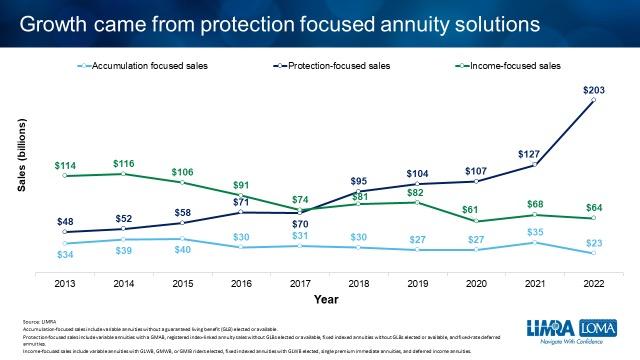


There are also demographics that will affect the future of annuities, with more people reaching an age when they would consider purchasing one. The average age of an annuity buyer is in the early 60s, with the majority of annuities purchased by people aged 55—70. According to Oxford Economics, the U.S. population aged 65 or over is expected to grow by more than 8.3 million from 2022 to 2027.
cial professionals could no longer ignore annuities. It’s likely that more financial professionals entered the annuities space in response to their clients’ needs for the solutions these products offer. This may help going forward as demographics shift and this age category grows.
In 2022, there was $113 billion in new FRD sales. Most of those contracts will mature in 2025, 2027 and 2029. Where, then, does that money go? Does it go into an FIA or a RILA, or does it remain in the FRD? For conservative investors, it likely will stay in an FRD, but a lot depends on economic conditions as well as the investors’ needs.
Financial professionals should remain flexible and be willing to find solutions for their clients regardless of future markets or interest rates. There will always be a need for lifetime income and financial security — particularly as more people in the U.S. near retirement age.
Todd Giesing is assistant vice president, LIMRA Annuity Research. He

may be contacted at todd.giesing@innfeed-
back.comStudies show that retirees whose income is protected live longer, happier lives.
 By Bryon Holz
By Bryon Holz
If we take a holistic approach to financial planning, we include numerous insurance components in our clients’ plans. We help them insure their lives, health, wages, cars and homes. Doesn’t it also make sense to protect and insure their retirement income?
Retirees have worked hard for many years to build their retirement nest eggs. They want to know their savings are protected and can work for them when they’re no longer working. Defined benefit pensions have virtually disappeared, so the need for a similar, pensionlike benefit has never been stronger.
Bring on annuities — the only products that can provide retirees with a guaranteed income for life, no matter how long they live. Annuities are the best insurance we can offer to people who worry they might outlive their savings.
I started my profession helping educators plan for retirement and used annuities from the very start with TSAs — tax-sheltered annuities — in the 403(b) market. As my practice has grown to include clients from a broad variety of professions and backgrounds, I’ve found that annuity products offer a great solution for many of my clients.
The numbers and science make sense — annuities work. They spread retirement income risk among thousands of clients over many years to provide security. Annuities also make sense from an emotional standpoint. I live in Florida, aka “heaven’s waiting room,” where our many retirees need and desire protected retirement income. My clients love both receiving protected income from their retirement annuities, as well as not having to worry about market volatility derailing their retirement plans.
During times of large market swings
such as those we’ve had recently, it really makes client reviews much easier when I can soothe client concerns by talking about their protected income. The benefits go far beyond making my job easier. Studies show that retirees who don’t have to worry about their portfolio, whose income is protected, live longer, happier lives.
Very few financial products are one-sizefits-all, and annuities are no exception. As advisors, we serve our clients’ best interests by having an open mind about newer types of annuities and how they can meet our clients’ specific retirement income needs or offer solutions based on clients’ unique situations.
Certain annuities can provide what some might consider nontraditional benefits, including enhanced death benefits, tax-deferred growth, long-term care benefits and more. Registered index-linked annuities are an example of that. Also, many annuities have significantly shorter surrender charge periods than they did in past decades, providing greater flexibility for the various solutions they provide. Rising interest rates have enhanced many withdrawal rider benefits as well.
I use a “bucket” approach to retirement planning. Different buckets have different purposes to serve different types of clients. These buckets typically include a mix of mutual funds and annuities as part of a client’s overall portfolio.
Resources abound
The great news for advisors is that there
is a lot of information available to help us and our clients understand the benefits of annuities.
I love the Alliance for Lifetime Income’s many resources and materials, including many that are client-friendly and readymade for use in social media. I also love how the alliance has sponsored the Rolling Stones’ last two concert tours and Elton John’s Farewell Yellow Brick Road our, literally playing to our audience — baby boomers seeking a secure retirement!
Another good source of consumer information is NAIFA’s FinancialSecurity. org website. Being a NAIFA member, I have access to some of the industry’s foremost experts, including people such as Tom Hegna and Moshe Milevsky, in my professional network.

Most annuity providers also have wonderful general marketing information and third-party materials about how annuities can help clients.
June is National Annuity Awareness Month, and it’s the perfect time to help our clients understand the value of these important planning tools. Having annuities available among our many products and services truly bolsters and supports our ability as financial professionals to help build brighter tomorrows for our clients.
Bryon Holz, CLU, ChFC, LUTCF, CASL, LACP, is the president of the National Association of Insurance and Financial Advisors. He founded Bryon Holz & Associates in Brandon, Florida, in 1983. He may be contacted at bryon.holz@innfeedback.com.


the number of people covered by individual life insurance. In 2021, the policy count in New York state stood at 362,207, down 15% from the 2018 total, the year before the rule took effect. But over the same period, the policy count nationally increased by 3%.
In addition to this, we’re also hearing about how burdensome it is for advisors to serve their clients.
For example, Bob Eichler, an advisor at CCL Financial Group in New York City, said, “My concern is that the process keeps people from acquiring the coverage that they should have. If you’re planning on having to complete 100 pages of an application, that just tends to make them procrastinate even longer.”
Ben Kronish, an advisor at PartnersFinancial and the insurance broker and consultant NFP in New York City, has publicly noted, “When you add the additional requirement that Regulation 187 imposes, it just becomes a reason to look to do business outside of the state.”
I think we can all agree that putting consumers’ true best interest first is a laudable goal and one we should — and can — achieve. We’ve seen it at the congressional level recently, with SECURE 2.0, and we continue to see it with the adoption of the National Association of Insurance Commissioners’ Best Interest model.
A path forward with laws like these two will ensure middle-income savers have access to the financial advice and tools they need for true financial security, including life insurance, investments and annuities.
need more access to financial advice and more choices about how to invest.
By Melissa BovaWhen four in five Americans tell a Wall Street Journal poll they believe the state of the economy is “not so good” or “poor,” an overwhelming share of Americans aren’t confident their children’s lives will be better than their own and we see bank failures such
as what happened with Silicon Valley Bank, it’s easy to let pessimism set in. But at Finseca, our mission is right there in our name: FINancial SECurity for A ll. And that’s why we will continue to draw attention to New York state’s Regulation 187, which — as the data show — has been problematic for consumers looking for access and more choices.

As was stated in a recent industry trade publication, “New York’s Regulation 187 has added unnecessary time and cost to the life application process. It could also be depressing sales.”

For example, we’ve seen a decline in
With roughly 60 million American households having no or not enough life insurance, that means millions don’t even benefit from the protection of a true financial security plan. Couple this with the roughly $12 trillion protection gap, and our work at Finseca is squarely focused on ensuring consumers have more access and more choices.
When you add the additional requirement that Regulation 187 imposes, it just becomes a reason to look to do business outside of the state.

Helping people claim Social Security is a natural segue to other retirement-related financial, tax and insurance discussions.
By Ernest J. Guerriero and Martha SheddenAs professionals understand their role in the planning process, they also must understand when to reach out to an expert. If you are acting in a client’s best interest, you must know when to reach out to another professional who has expertise in topic areas where you do not. Life insurance professionals who are not CPAs or attorneys know they cannot provide tax or legal advice. Social Security is similar; specialized expertise is needed.
Social Security is complex and confusing, consisting of more than 2,700 rules. Considering the intricacies in this area, it is easy to make a mistake that could be costly
for the client. The advisor and the client have one chance to get Social Security right. A professional who is a Registered Social Security Analyst would be valuable to your team. As we move into what some are tentatively calling the “post-pandemic” world, what now? What are some of the lasting effects the pandemic will have on our industry and how advisors work?
The problem: Financial, insurance and tax professionals want to be in a position to introduce themselves and their specific skills, products and plans to prospective clients.
The solution: American workers want and deserve to receive all the Social Security income they are entitled to.
Social Security income planning is just that — planning for the most optimal time and strategy for individuals, couples and families to claim their benefits in the context of all their other financial related retirement decisions. The discovery process of helping people with Social Security is a natural segue to other retirementrelated financial, tax and insurance details.
» Financial: Anyone waiting to claim Social Security to take advantage of delayed retirement credits must be able to “bridge the income gap” with other funds

Social Security is complex and confusing, consisting of more than 2,700 rules. The advisor and the client have one chance to get Social Security right.
if they plan to stop working earlier than the claiming date. The discussion of if and how this is possible for clients involves all their income and assets.
» Insurance: The need for Medicare; other health, life and long-term care insurance; and annuities is interrelated with the amount of Social Security retirees will be collecting. Social Security is the perfect special partner topic for your Medicare, health, life, annuity, long-term care and other insurance plans.
» Tax: The interplay between income tax and the special way that Social Security benefits are taxed opens the door to comprehensive retirement withdrawal strategies and tax planning. What is the most beneficial sequence of withdrawals from a client’s taxable, tax-deferred or nontaxable accounts?
It is only when delving deep into a specific situation that the consequences
are revealed to those unfamiliar with the complexities of Social Security rules and the financial impact the claiming decision has on long-term retirement finances.

As an example, let’s look at the rules surrounding the earnings test. These rules apply only to those who are are younger than full retirement age, have started collecting Social Security benefits and are still working.
The Social Security Administration does not consider someone in this age group “retired” if they have earnings over certain limits. This means they withhold a certain amount from future Social Security checks, depending on how much is earned over those limits.

The chart below shows the 2023 earnings limits information.
The problem with the earnings test comes when individuals are not aware of the rule, have not let the SSA know about
62 to year of FRA $1 for every $2 earned above $21,240 Year of FRA $1 for every $3 earned above $56,520
No limits after month of FRA
the earnings and have been paid full benefit amounts before the SSA discovers the income. This results in an overpayment of sometimes substantial amounts required to be paid back to SSA.
The amounts withheld are not “lost.” Once the individual reaches FRA, the recipient receives a larger benefit check from that point on. The recalculation, known as the adjustment of reduction factor at FRA, determines how many months of benefits were withheld.
Claiming Social Security prior to FRA resulted in a lower amount subject to the reduction rates. For example, assume this individual had an FRA of 67 and a full benefit (primary insurance amount) of $2,000 per month. They began collecting benefits at 62, so they would have received 70% of $2,000, or $1,400. If they had waited until age 63 to collect, they would have received 75% of $2,000, or $1,500.
If the benefit is $1,400 per month and a total of $16,800 was withheld, that is 12 months, or one year, of benefits. Therefore, as calculated above, the individual’s monthly benefit amount would increase from $1,400 to $1,500 at FRA.
An advisor who understands this rule can help clients coordinate their claiming age with anticipated future work plans or, if after the fact, help them quickly resolve the overpayment issue.
The Social Security timing decision should not be made in a vacuum without considering all other financial, tax and insurance factors that affect retirement. It is a unique and special piece of the retirement planning puzzle. But it is a puzzle that almost all Americans will need to solve.
Ernest J. Guerriero, CLU, ChFC, CEBS, CPCU, CPC, CMS, AIF, RICP, CPFA, national
president of the Society of Financial Service Professionals, is the director of qualified plans, business markets for Consolidated Planning Inc. He may be contacted at ernest.guerriero@ innfeedback.com.
Martha Shedden, RSSA, CRPC, is president and co-founder of the National Association of Registered Social Security Analysts. She may be contacted at martha.shedden@innfeedback.com.


